ip access IPA219C 3G Picocellular basestation User Manual nano3GAP Installation Manual
ip.access ltd 3G Picocellular basestation nano3GAP Installation Manual
Contents
- 1. Installation guide
- 2. Operating guide
- 3. Installation manual
- 4. Operating manual
Installation manual
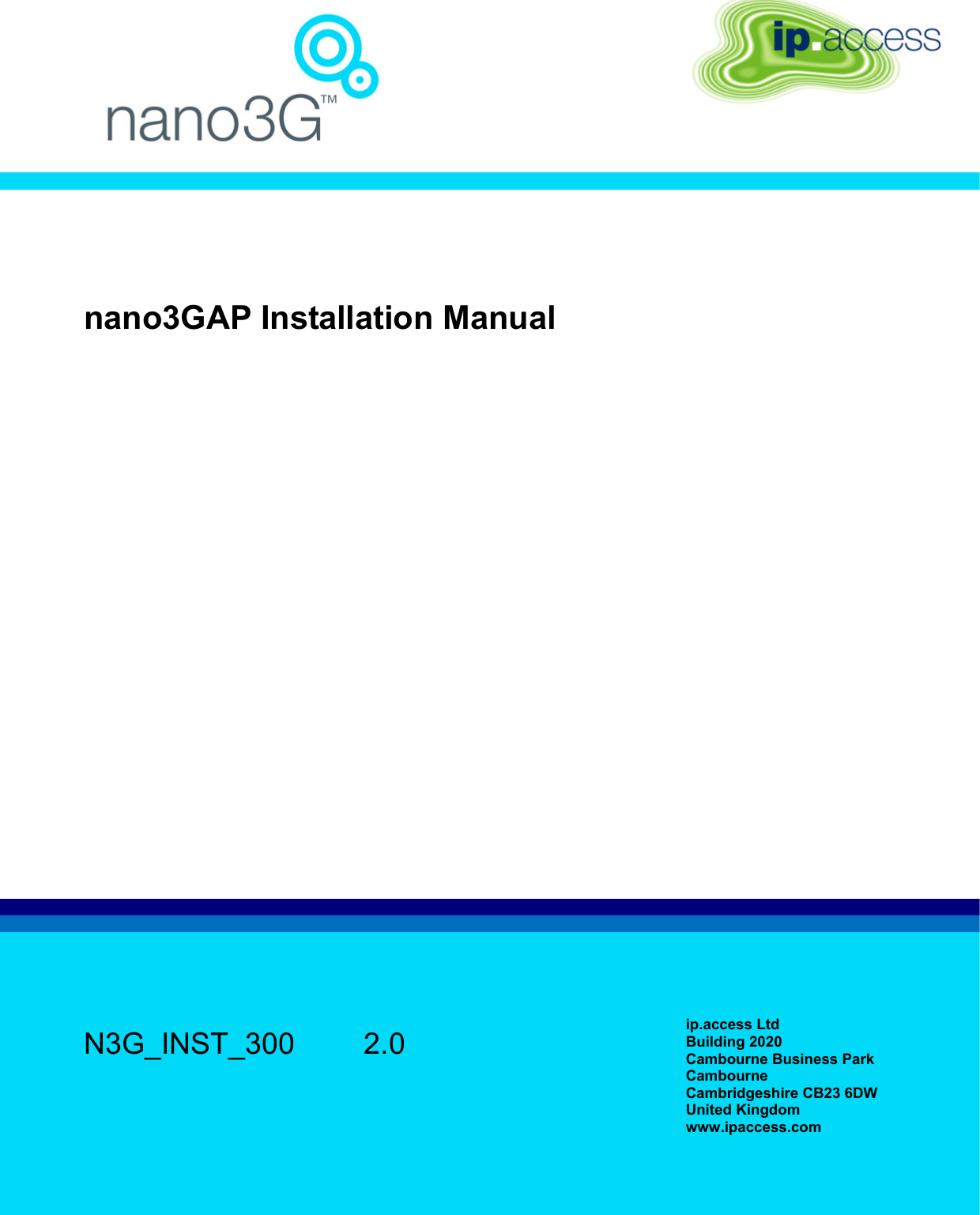
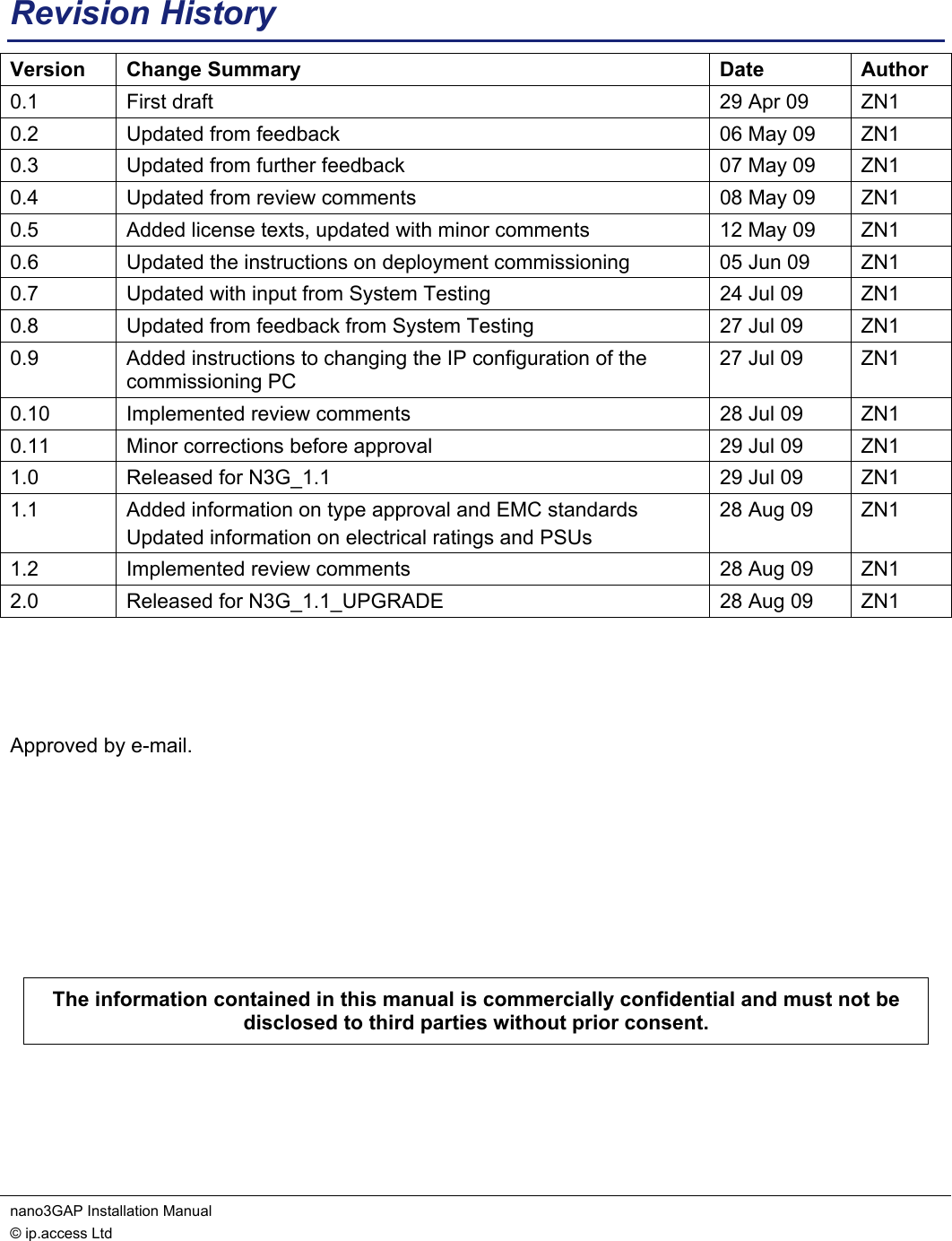
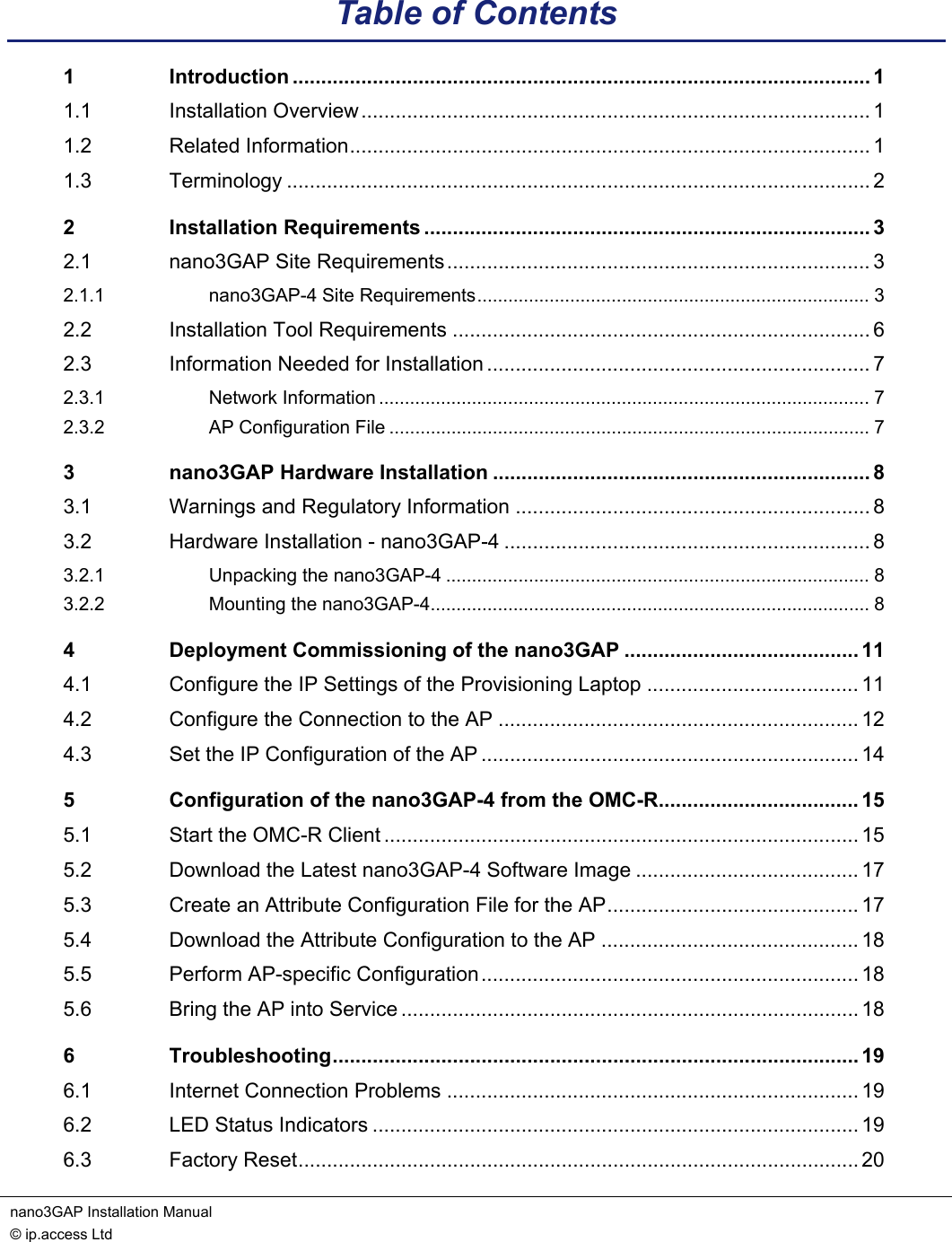
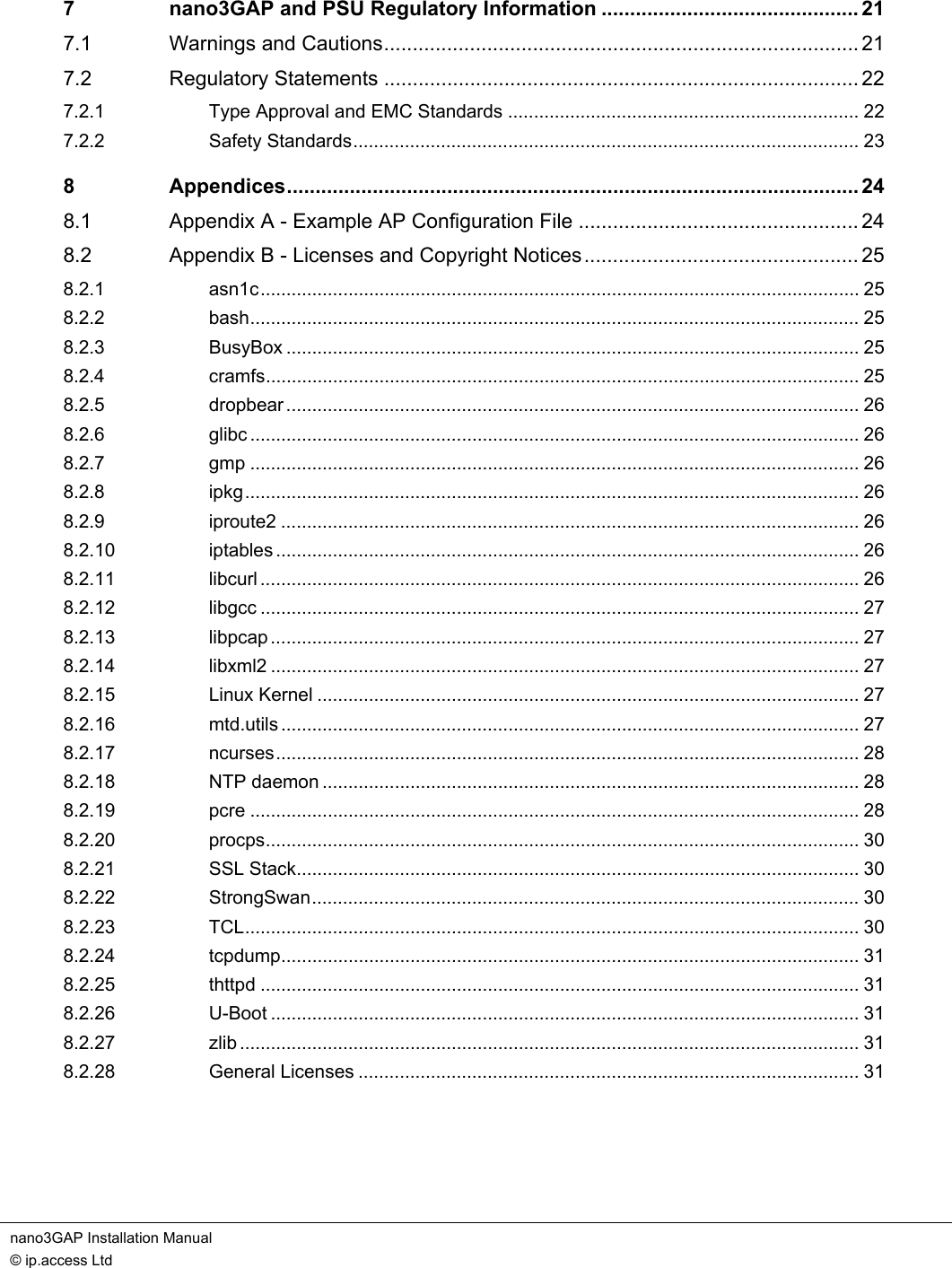
![nano3GAP Installation Manual Introduction © ip.access Ltd Page 1 1 Introduction The ip.access nano3GAP-4 is an indoor pico-class base station. This document provides the reader with all the necessary information required to install the ip.access nano3GAP-4. The document provides step-by-step instructions for hardware installation, PSU Installation, and configuration steps required to bring the nano3GAP-4 into service. The AP can be configured with a static IP address or it can obtain its IP address dynamically via DHCP. The AP-AC connection can be configured to be secure (via IPSec) or unsecured. 1.1 Installation Overview The principal activities for installing and commissioning a nano3GAP are: 1) Install the nano3GAP hardware and power it up (installation engineer on site, section 3). 2) Commission the nano3GAP for connecting to an AC and OMC-R (installation engineer on site, section 4). 3) Configure the nano3GAP from the OMC-R to bring it to into service (OAM engineer remotely from the NOC, section 5). 1.2 Related Information [GST_100] nano3G System Overview Manual (N3G_GST_100) [GST_120] nano3G System Planning and Provisioning Manual (N3G_GST_120) [GST_300] nano3GAP Product Description (N3G_GST_300) [GST_400] nano3G OMC-R Product Description (N3G_GST_400) [INST_200] Nano3G AC Installation Manual (N3G_INST_200) [INST_400] nano3G OMC-R Installation Manual (N3G_INST_400) [OPM_300] nano3GAP Operations Manual (N3G_OPM_300) [OPM_410] nano3G OMC-R Client Operations Manual (N3G_OPM_410) [OPM_430] nano3G OAM File Server Operations Manual (N3G_OPM_430) [REF_105] nano3G System Glossary (N3G_REF_105) [REF_150] Iu+ Networking Reference Manual (N3G_REF_150) [21.905] Vocabulary for 3GPP Specifications, 3rd Generation Partnership Project](https://usermanual.wiki/ip-access/IPA219C.Installation-manual/User-Guide-1170058-Page-5.png)
![nano3GAP Installation Manual Introduction © ip.access Ltd Page 2 1.3 Terminology For standard nano3G System terminology, see [REF_105]. For additional standard GSM terminology, see [21.905].](https://usermanual.wiki/ip-access/IPA219C.Installation-manual/User-Guide-1170058-Page-6.png)
![nano3GAP Installation Manual Installation Requirements © ip.access Ltd Page 3 2 Installation Requirements 2.1 nano3GAP Site Requirements 2.1.1 nano3GAP-4 Site Requirements The nano3GAPs are installed in retail or small office environments. In summary, each AP will require: • One of: o A suitable mains power supply point within [1.5] metres of the intended AP site. o Power over Ethernet (where mains power is remote). • An Ethernet connection that provides an IP address (via static addressing or via DHCP) and a route to the public Internet. A DNS service is also required to resolve symbolic addresses. • Site for wall mounting or a stable free-standing position. • Cat5 cable. 2.1.1.1 Power Maximum expected power consumption: 13 Watts (Rated 9VDC 1450mA) The nano3GAP-4 supports the following power and Ethernet cabling options at a site: • Direct power from a power adapter • Power-over-Ethernet o from a POE switch o from a POE inserter](https://usermanual.wiki/ip-access/IPA219C.Installation-manual/User-Guide-1170058-Page-7.png)
![nano3GAP Installation Manual Installation Requirements © ip.access Ltd Page 4 The connections are shown in the figure below. nano3GAP-4 Ethernet and power connections The power adapter, as well as the POE inserter and splitter supplied by ip.access comply with LPS requirements in accordance with IEC/EN 60950-1. Power Adapter A suitable mains power supply point into which the power adapter for the AP can be plugged. This should be within [1.5] metres of the intended installation position of the AP. Only use the power adapter supplied by ip.access to power the AP: ip.access part number EPS1173R manufactured by Dee Van Enterprise Co Ltd. model DSA-20P-10 input 100-240V ~ 50/60Hz 0.7A output +9VDC 1.67A Power over Ethernet POE comprises of a power inserter and a splitter. The power inserter is positioned close to the Internet connection, while the splitter is positioned close to the AP. Only use the POE inserter supplied by ip.access: ip.access part number 109A manufactured by PPI Co Ltd model ILA1711112 input 100/230V ~ 60/50Hz 0.5/0.25A output 48VDC 0.38A](https://usermanual.wiki/ip-access/IPA219C.Installation-manual/User-Guide-1170058-Page-8.png)
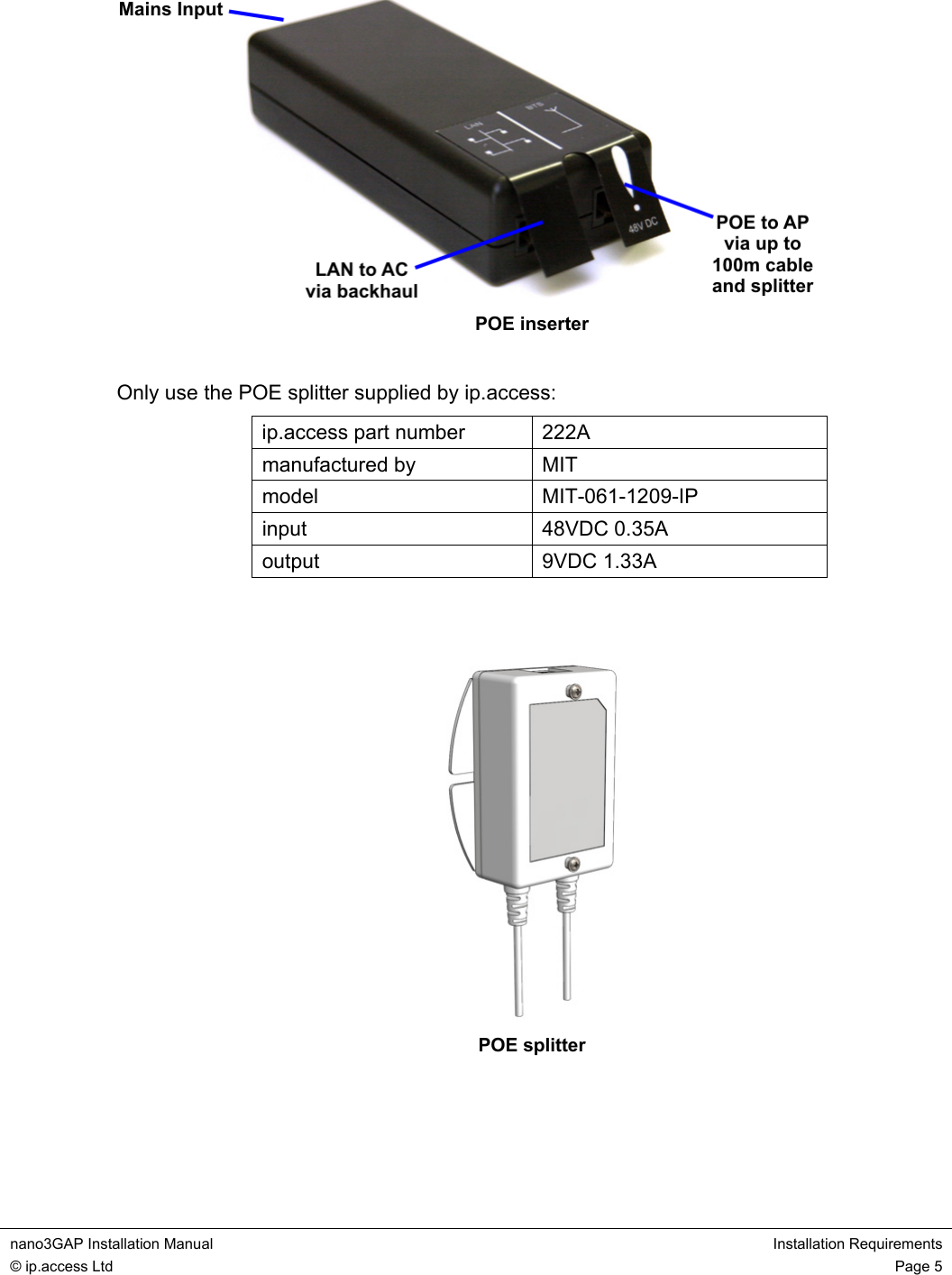
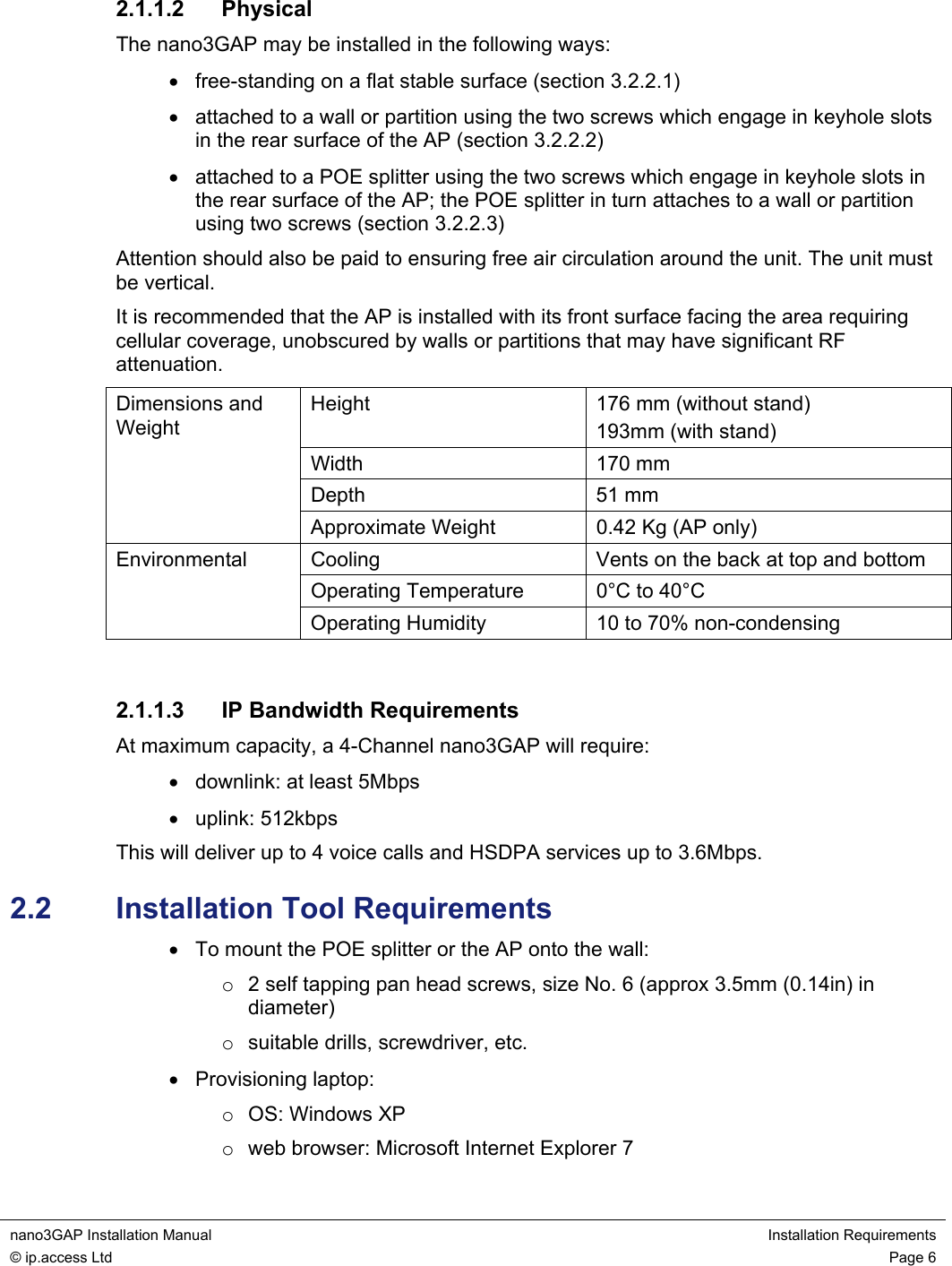
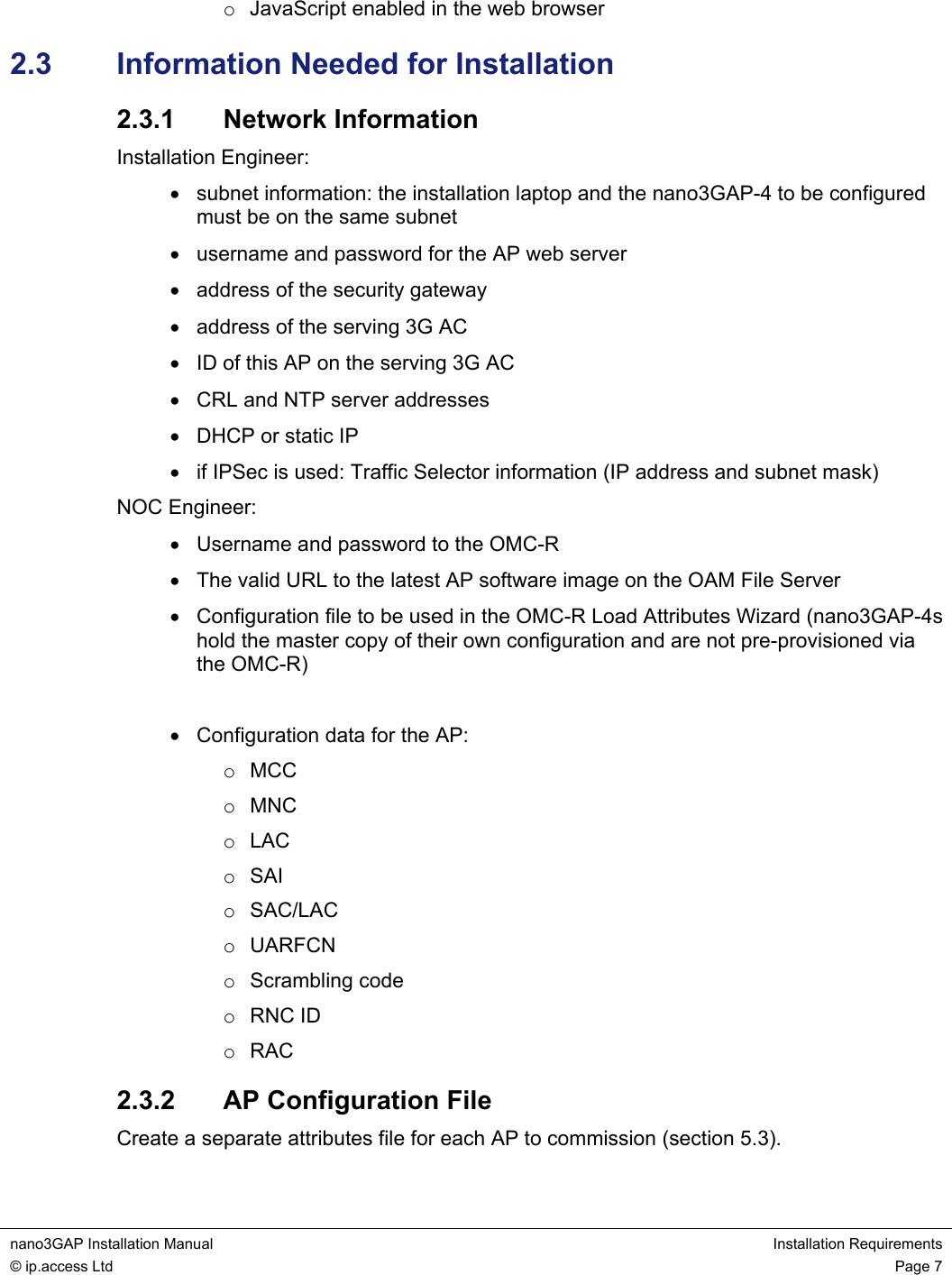
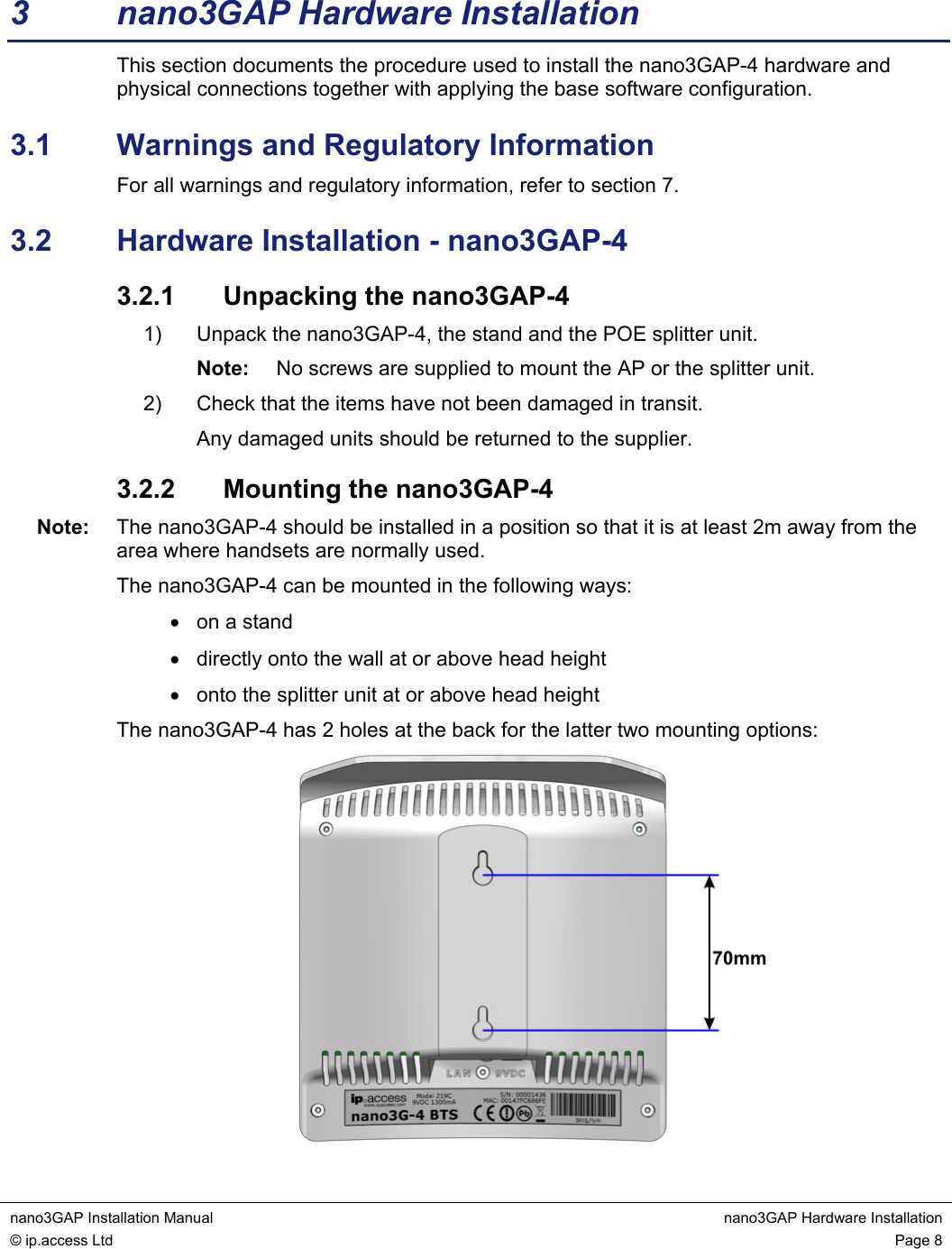
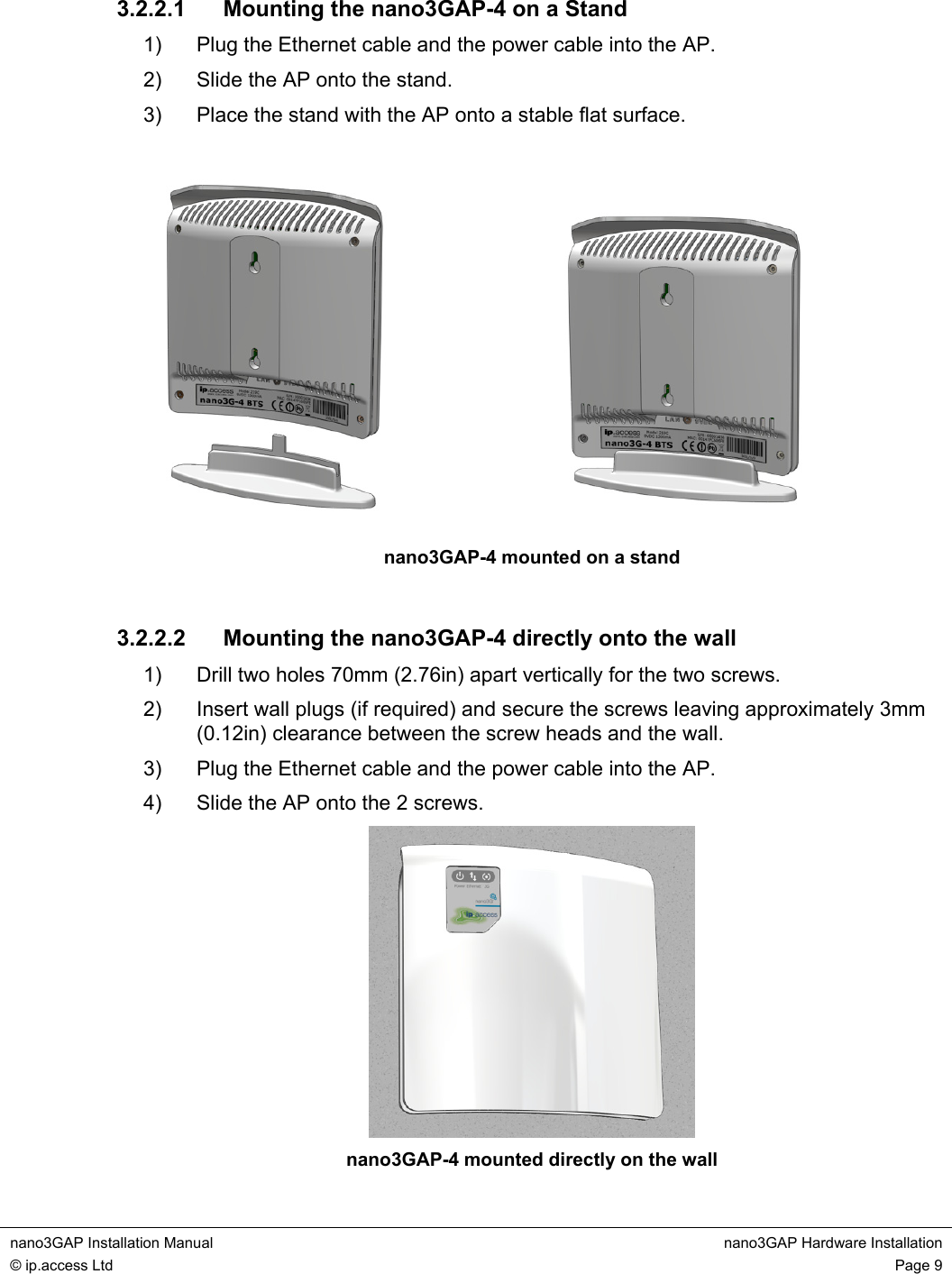
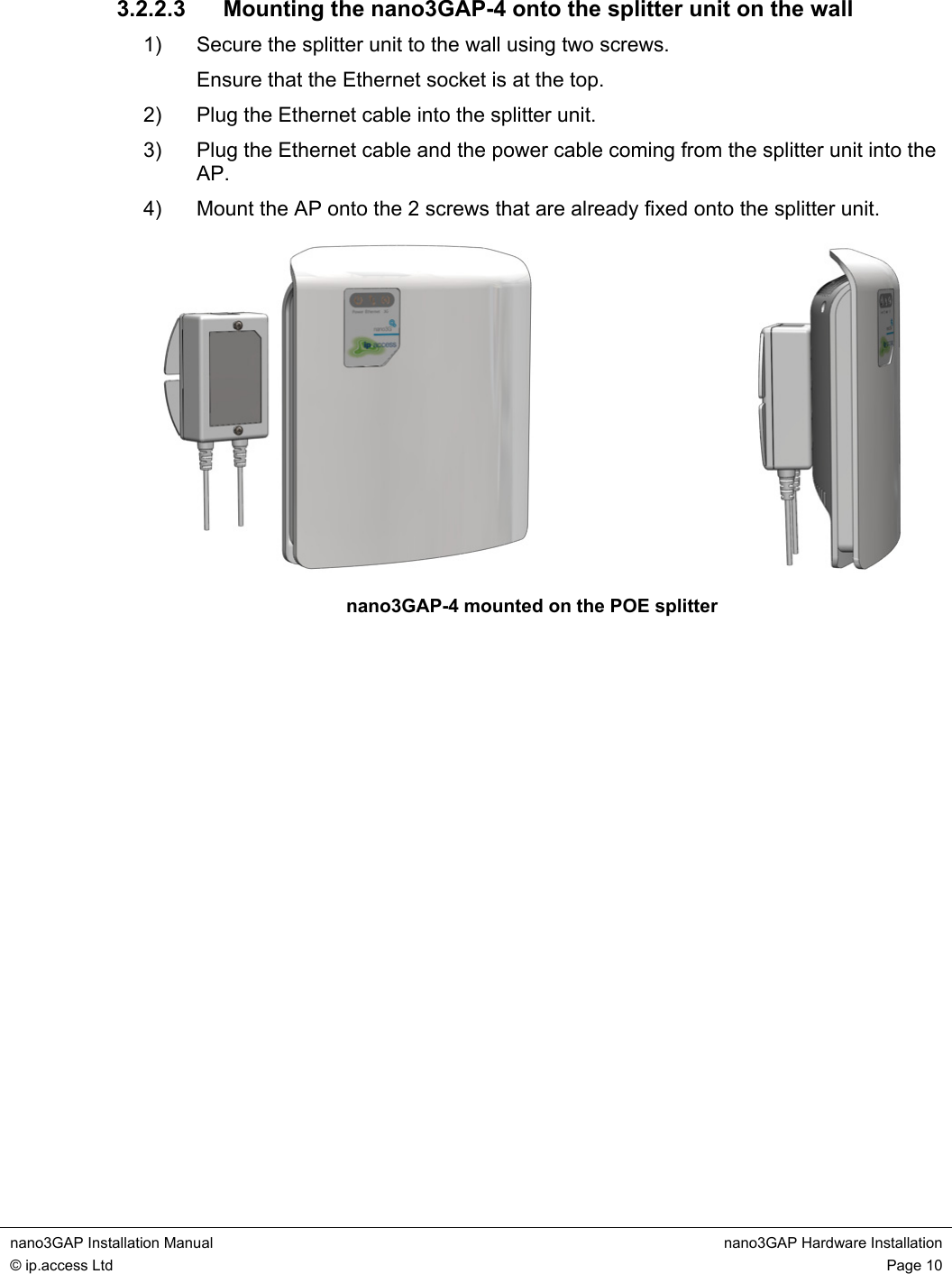
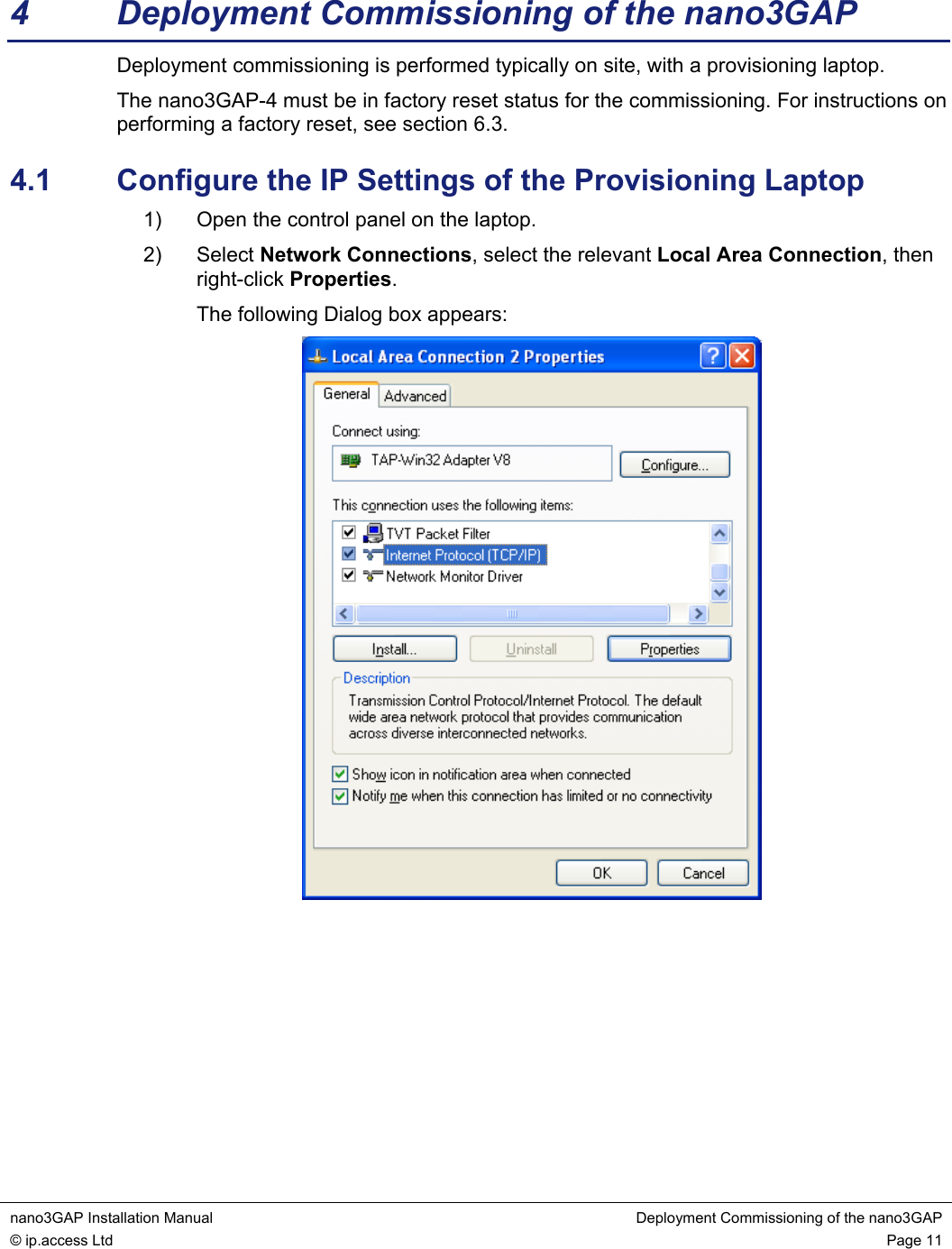
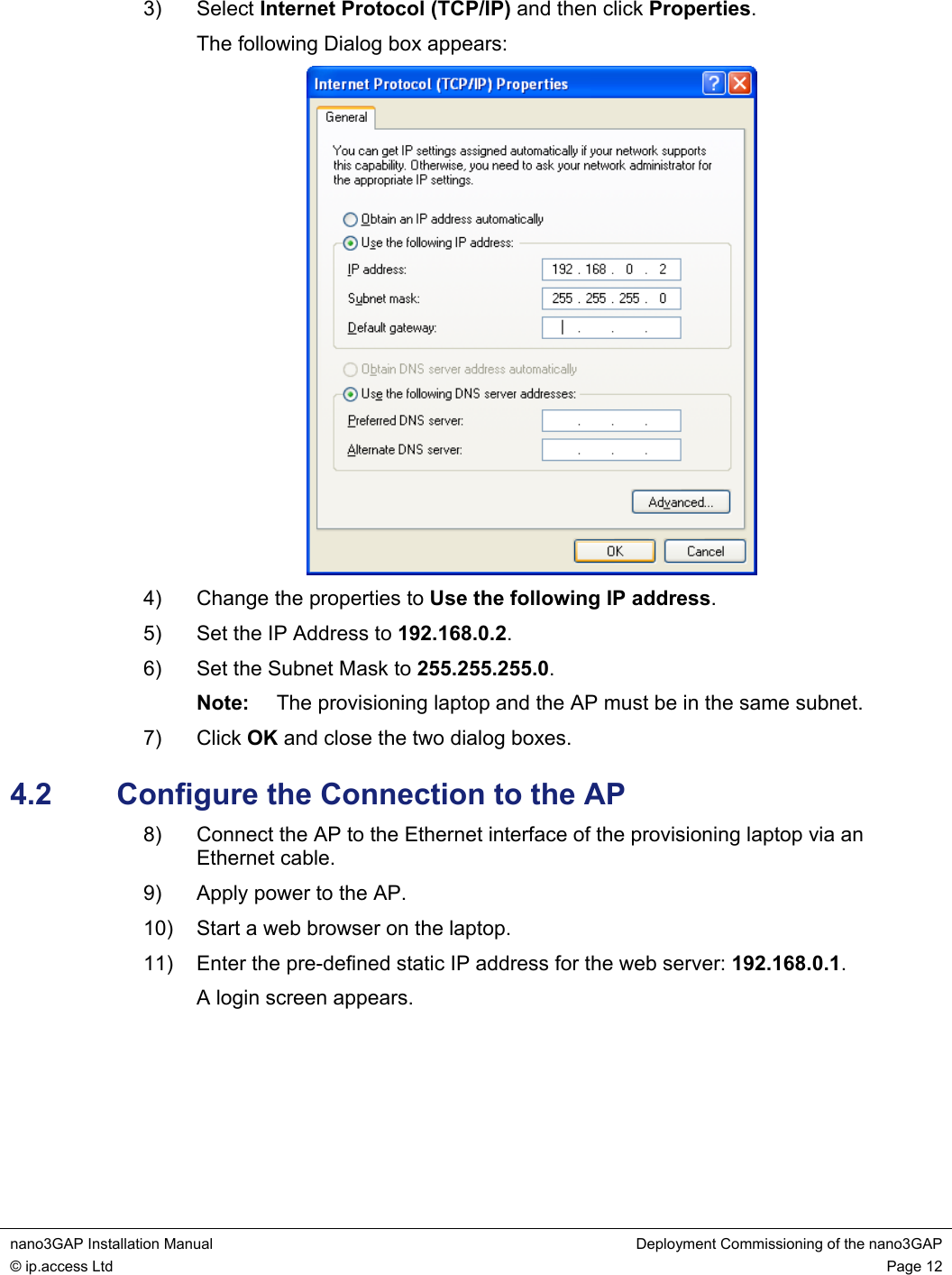
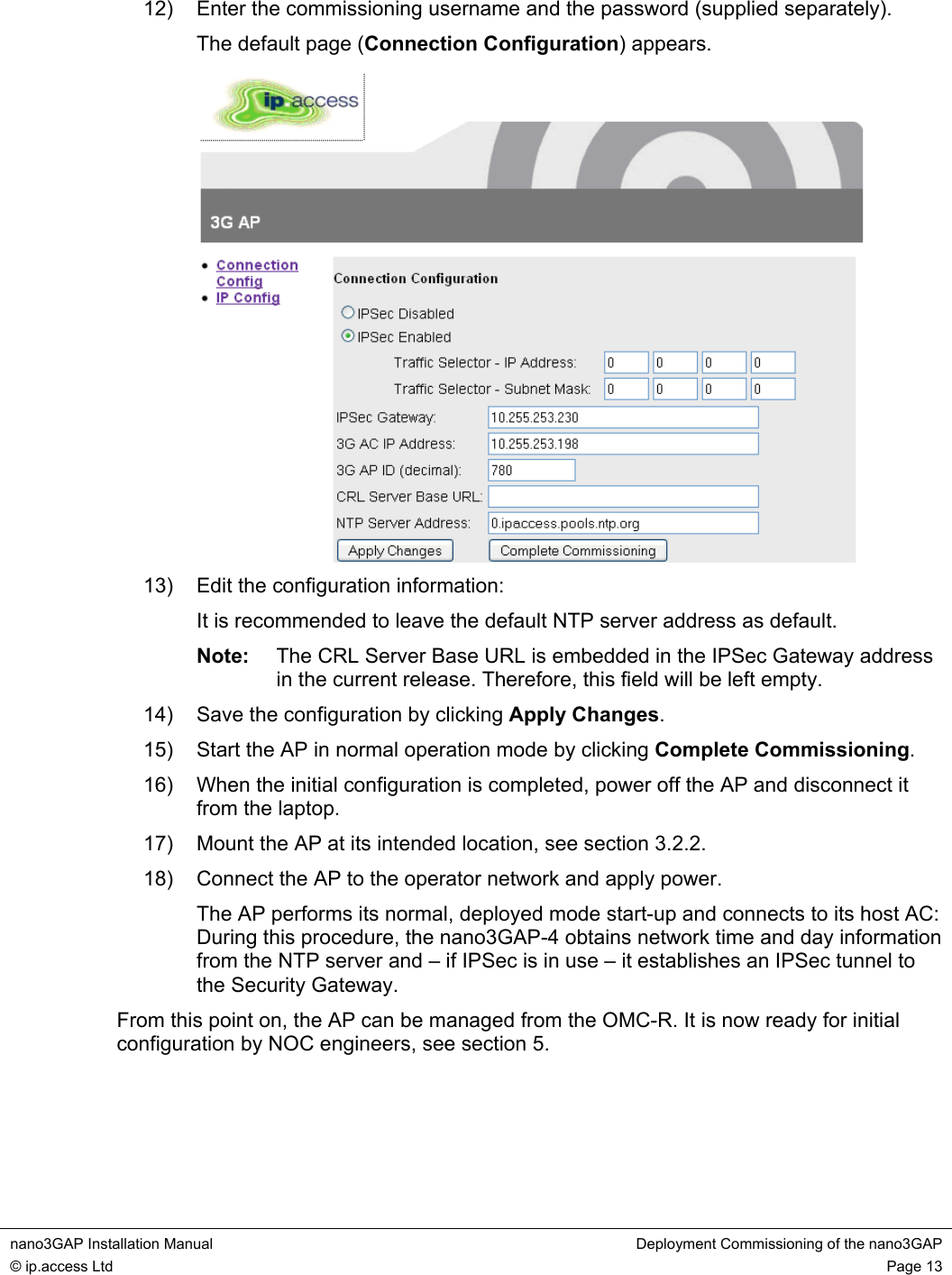
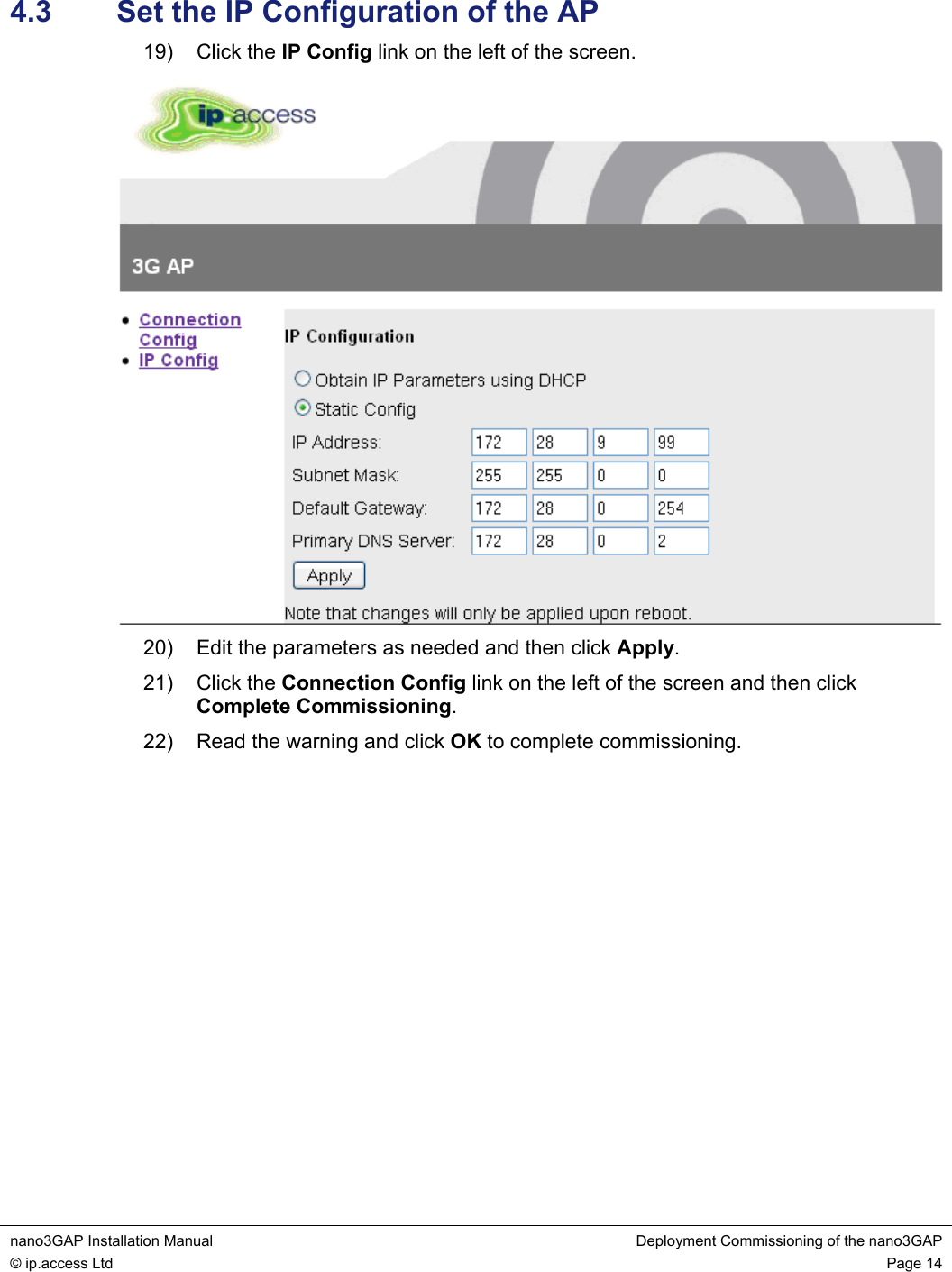
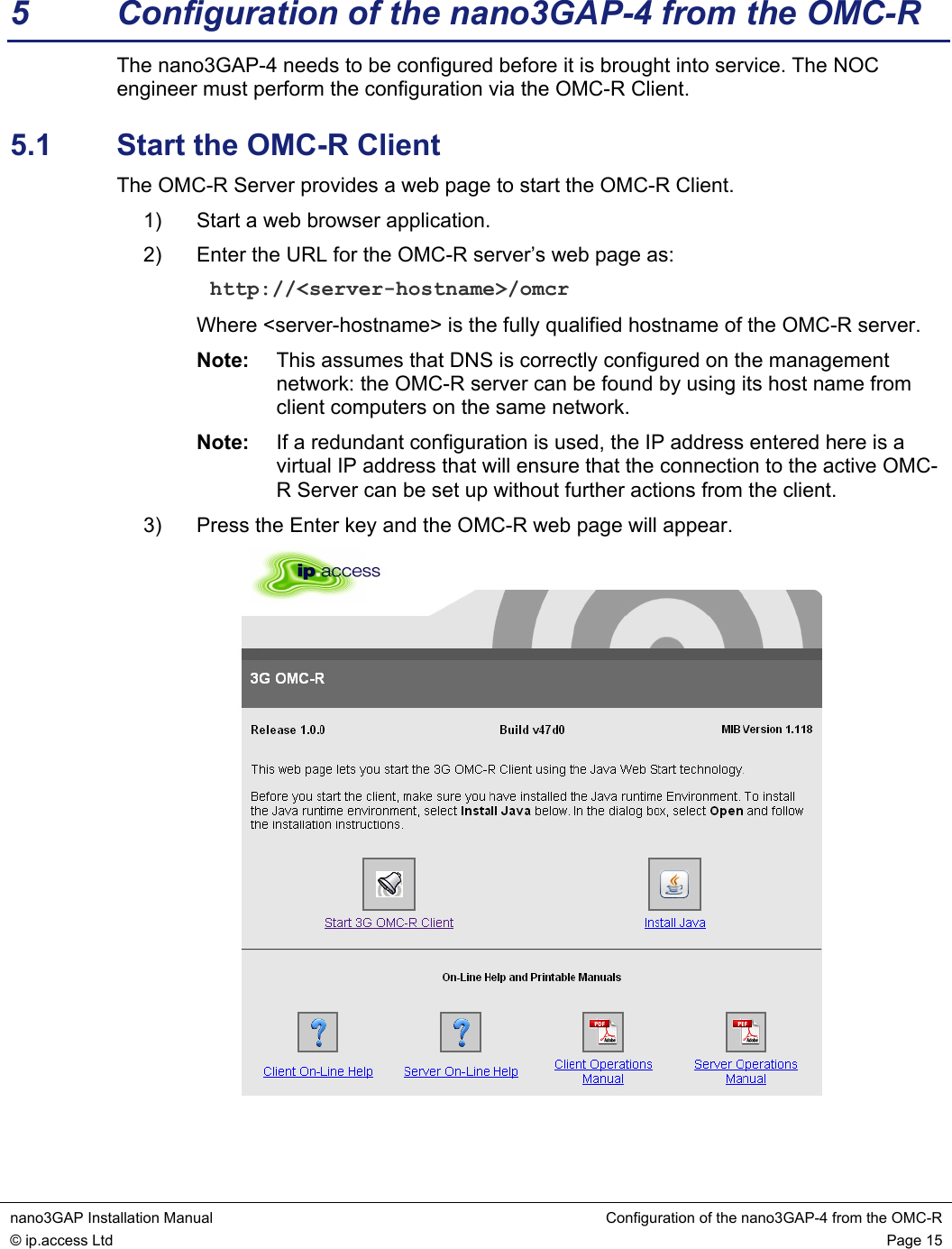
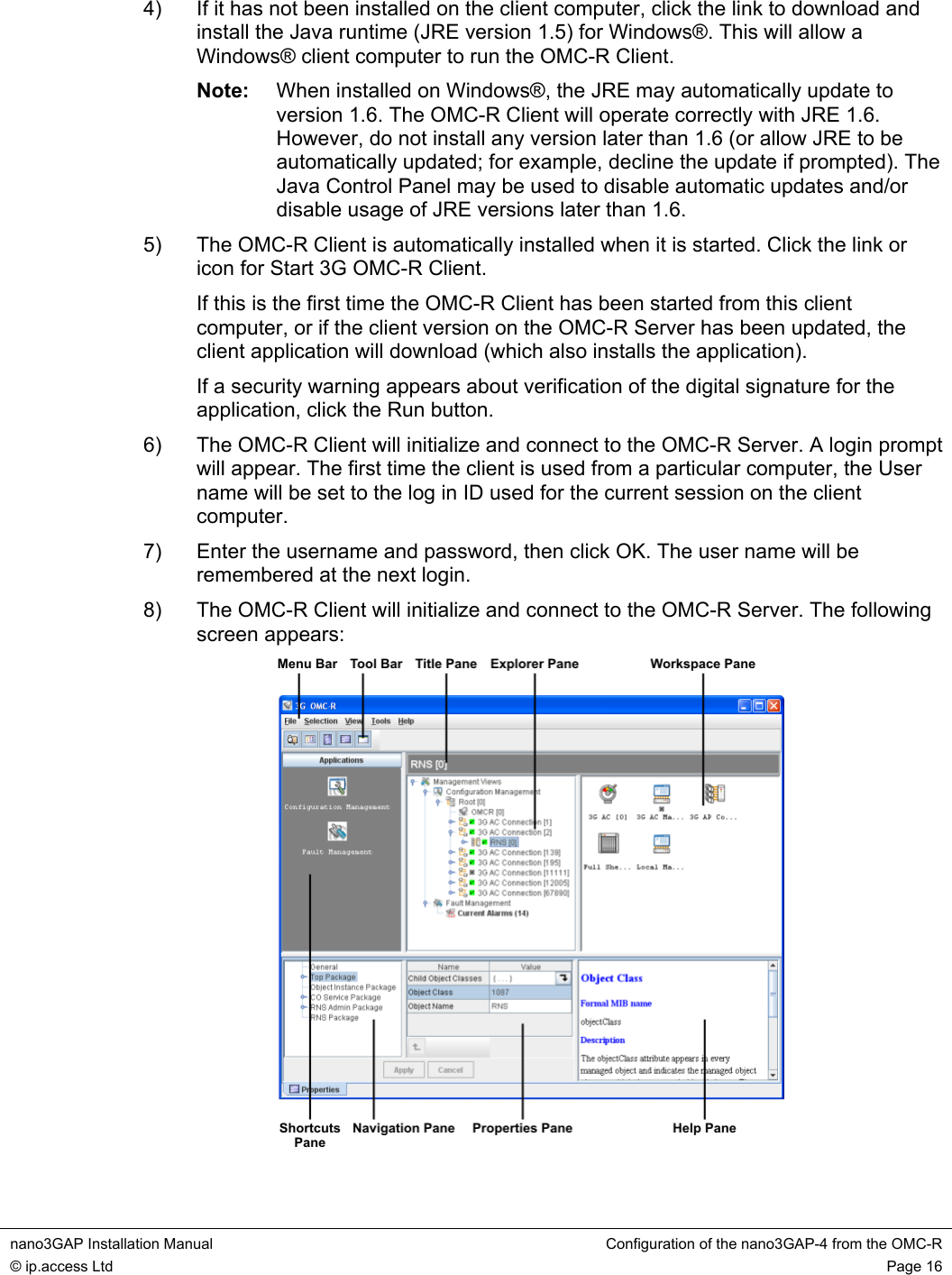
![nano3GAP Installation Manual Configuration of the nano3GAP-4 from the OMC-R © ip.access Ltd Page 17 9) Double-click through the tree (Management Views > Configuration Management) to navigate to the AP to configure. 5.2 Download the Latest nano3GAP-4 Software Image If the AP already has the latest software version, skip this section. The latest software image is downloaded to the AP from the OAM File Server. For instructions about how the software images are uploaded to the OAM File Server, see [OPM_430]. 10) Make sure that you have the URL to the latest software image file (SDP file) stored on the OAM File Server. 11) Select the AP in the OMC-R Client. 12) Right-click the AP, select Actions and then Perform Software Download. 13) In the Perform Software Download Actions window, enter the URL of the latest SDP file. 14) Select whether the image file should be downloaded only, or it should be swapped with the older image file, and whether the older image file should be removed from the standby folder on the AP. 15) Click Finish. The download in progress is indicated by the flashing network LED on the AP. 16) Monitor the 3G AP Admin Package of the AP object in the OMC-R Client. 17) When the standby software version is the version of the downloaded image, right-click the AP, select Action, and then select Swap Default Software. 18) Right-click the AP object again and then select Reinitialize. 19) Wait for the AP to be shown as connected to the OMC-R. 20) In the 3G AP Admin Package of the AP object, check that the Active Software Version is that of the new SDP. 5.3 Create an Attribute Configuration File for the AP The attributes to configure a nano3G-4 AP are stored in a text file. The file can be created and edited manually in any text editor. For a sample file, see section 8.1. To create the configuration file by using an existing one: 21) Log in to the OMC-R (see section 5.1). 22) Start the OMC-R Load Attributes Wizard: right-click on any existing AP object in the OMC-R Client and then select Save Attributes to File. 23) Save the file under a new name. 24) Edit the file in a text editor.](https://usermanual.wiki/ip-access/IPA219C.Installation-manual/User-Guide-1170058-Page-21.png)
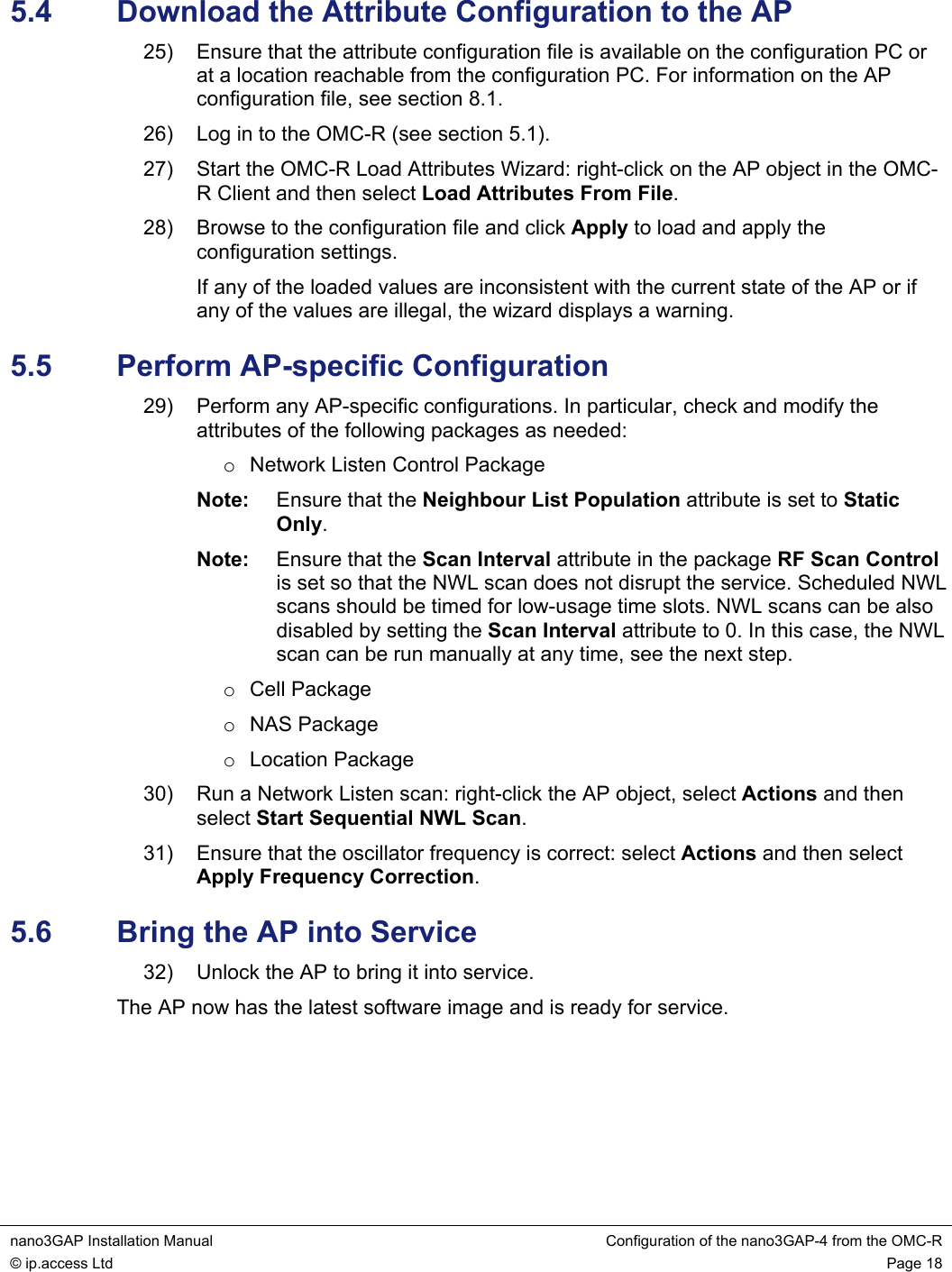
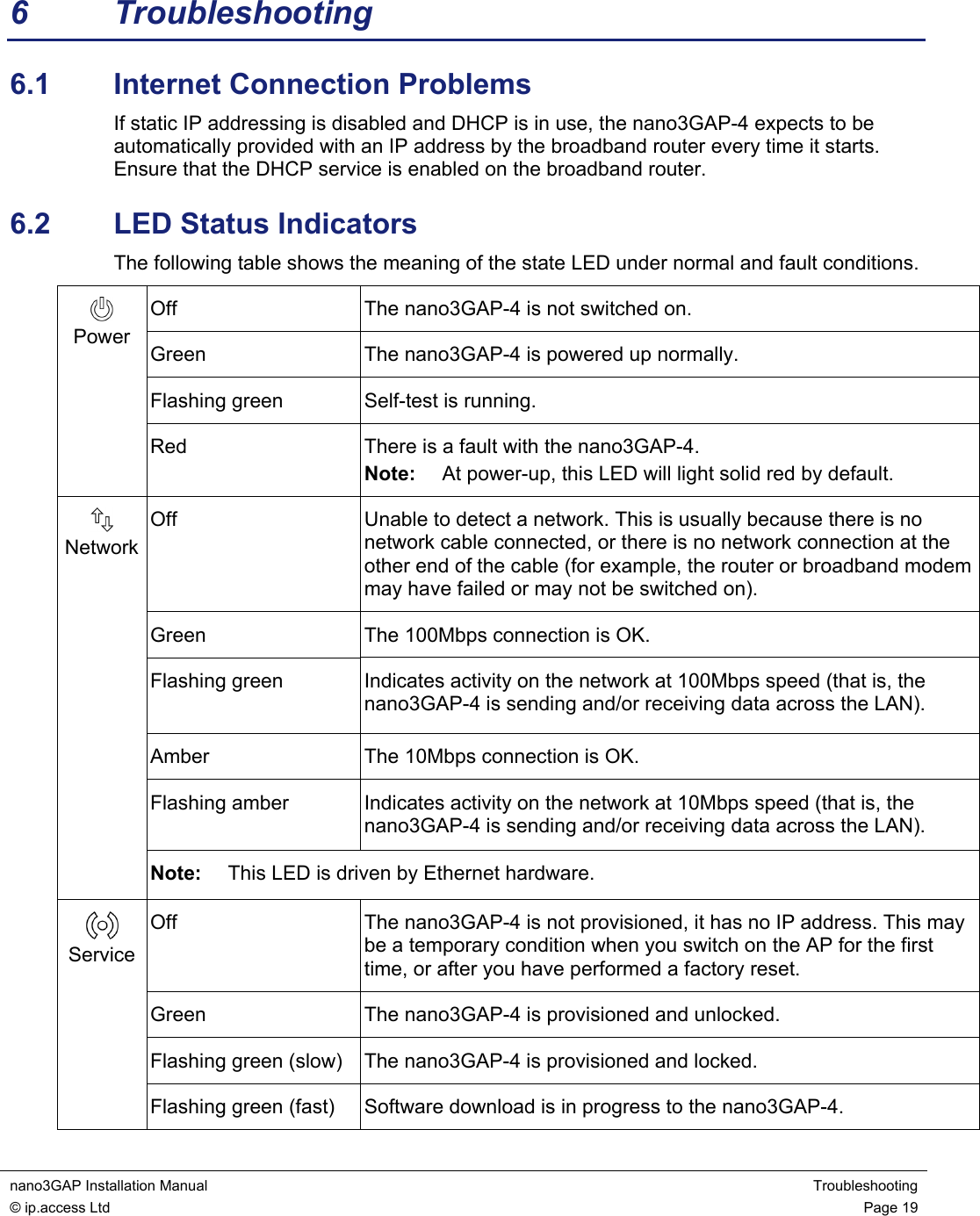
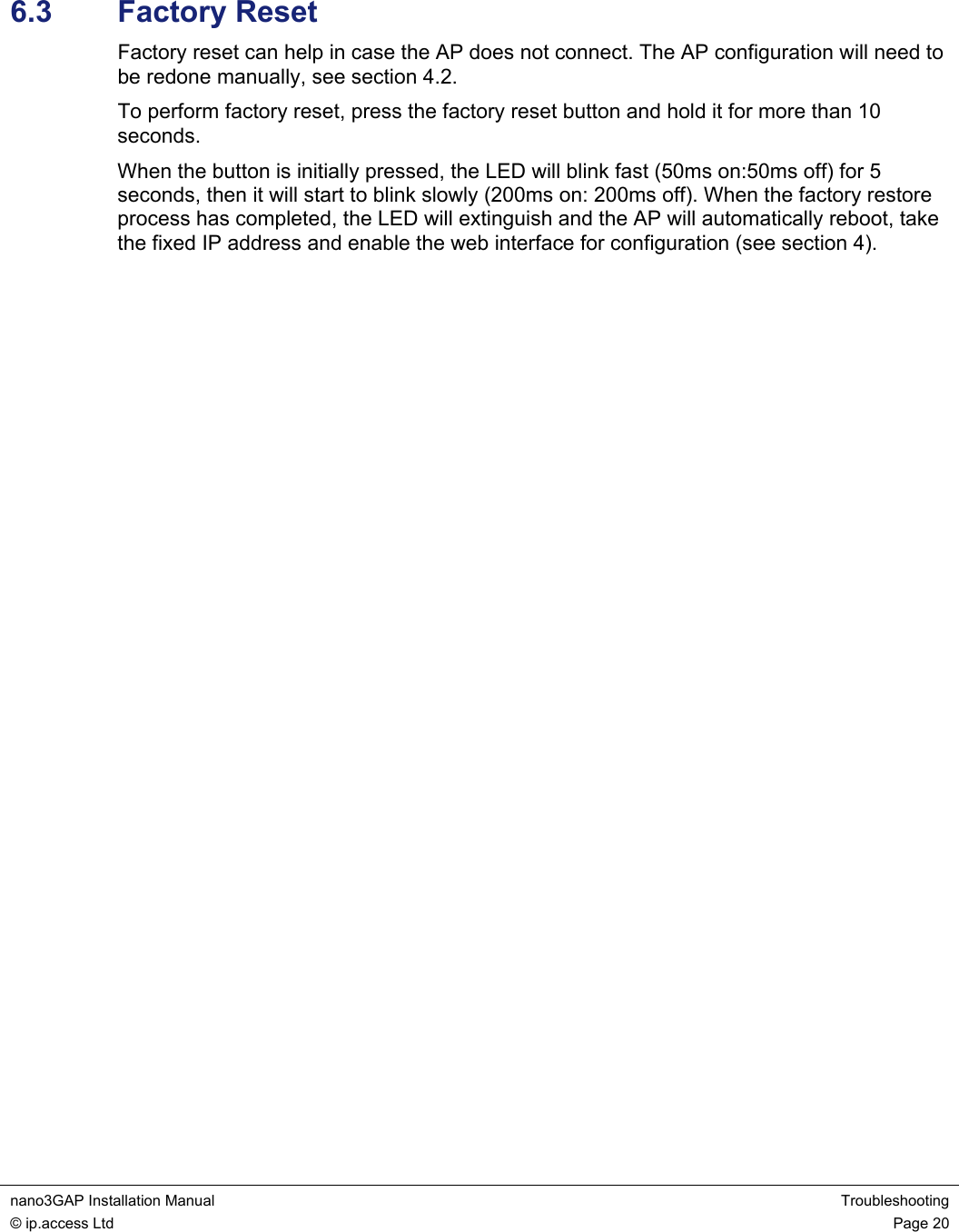
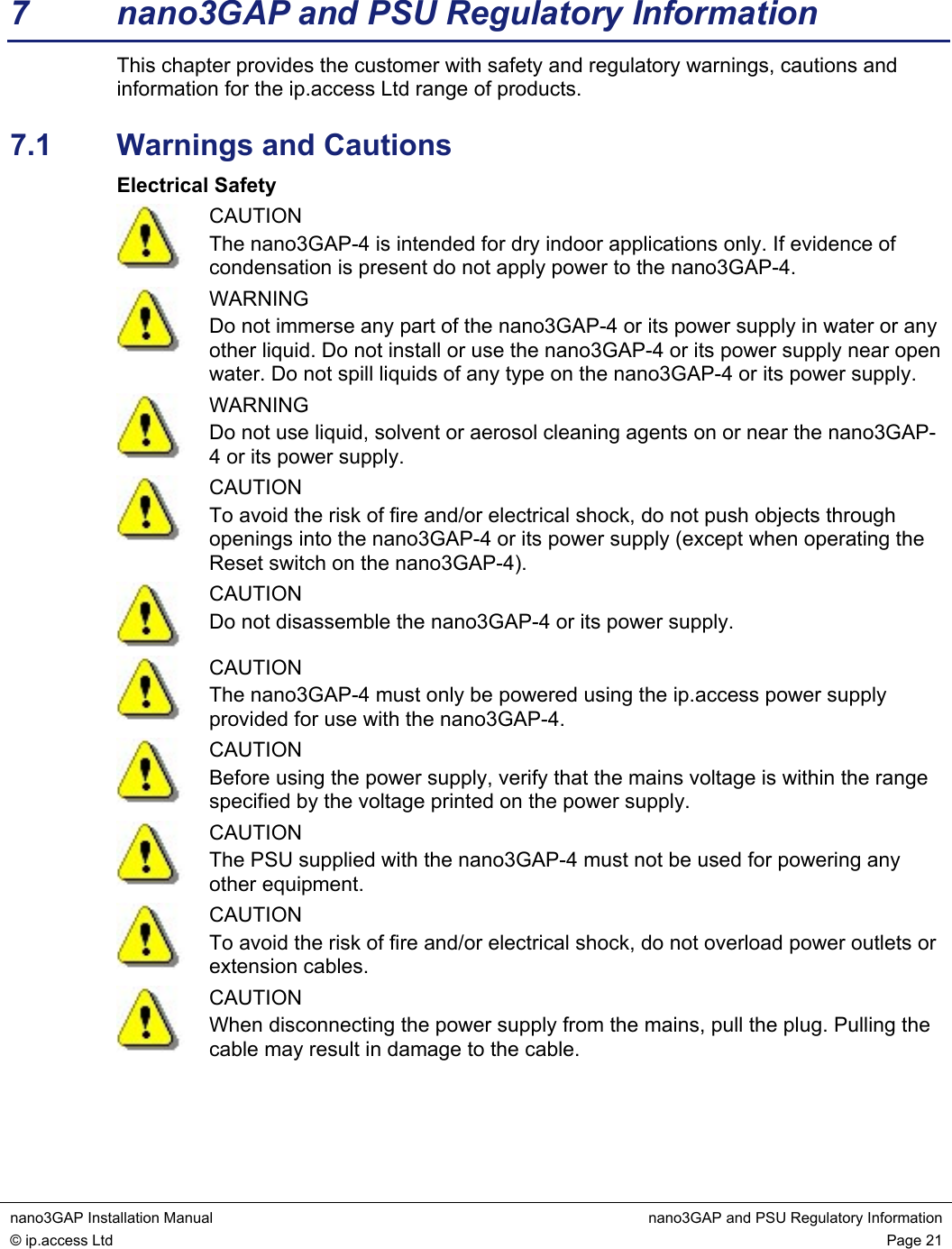
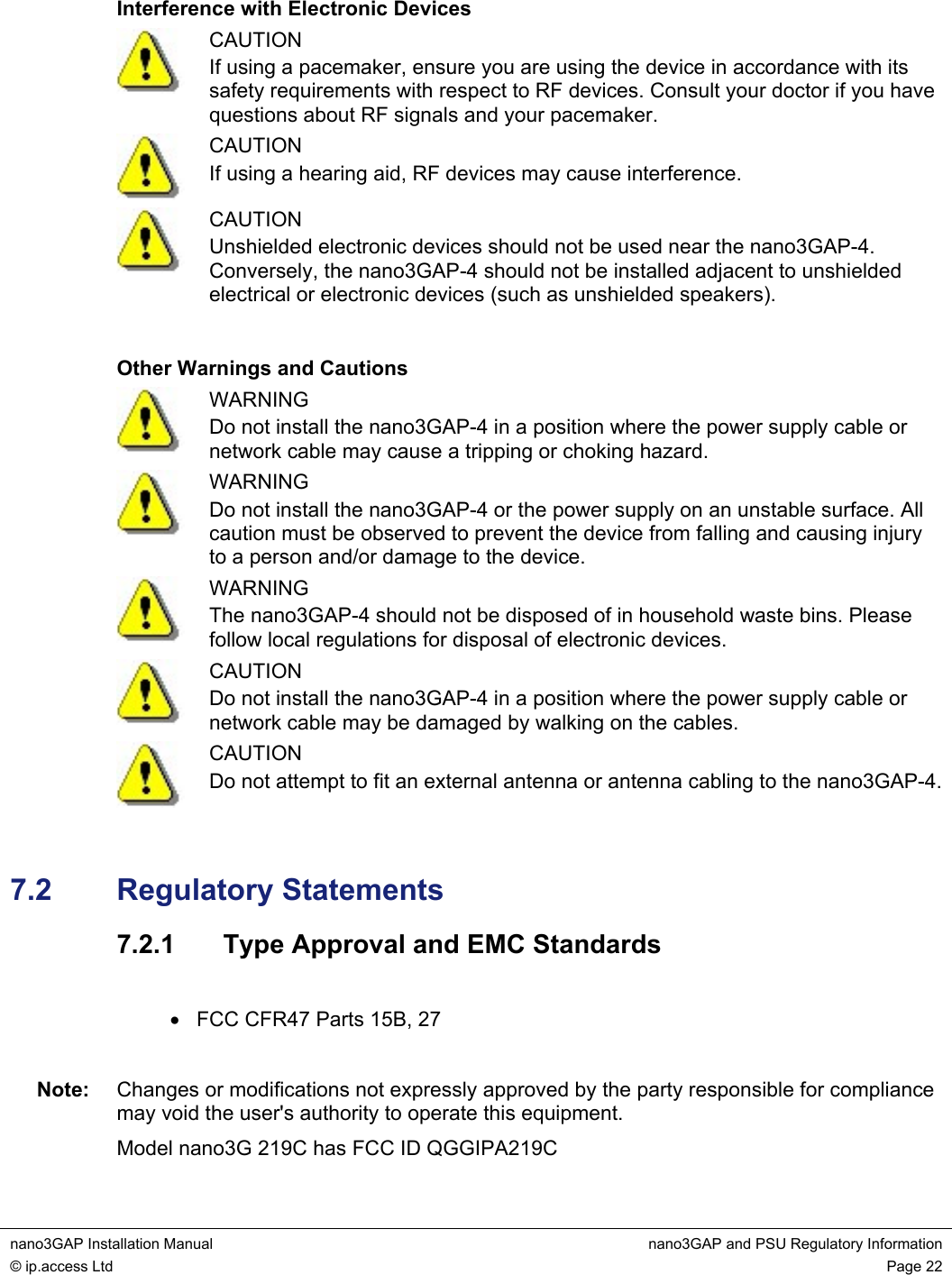
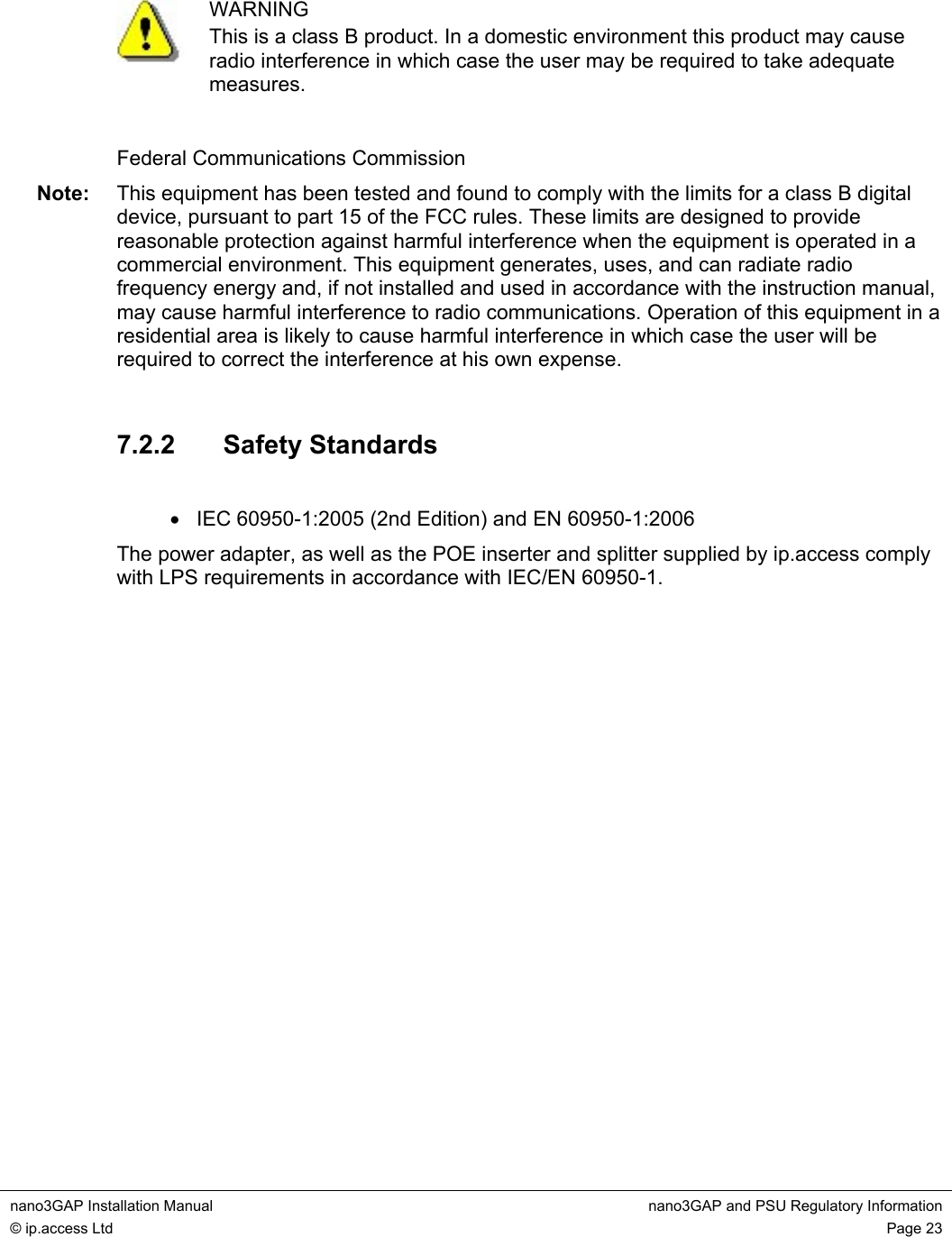
![nano3GAP Installation Manual Appendices © ip.access Ltd Page 24 8 Appendices 8.1 Appendix A - Example AP Configuration File A configuration file with the object name and the objects instance (relative distinguished name) must be created for each AP to be commissioned. For instructions to use the configuration file, see section 5.3. The file has to conform to the following syntax: • all non-comment lines are of the form <name>=<value> • comment lines begin with the hash character (#) • attribute types are as follows: o integer tos=0 o enumeration t300=T300_4000_MSEC o array ascPersistenceScalingFactors=[6,6,6,6,6,6] o boolean soipHeartbeatEnabled=true o structure cellBroadcastMessage={50,GSM_DEFAULT,”oyster 3G”} o string “HMAC-SHA1” o set alarmFilter=() # Instance for the AP to be modified Object=apNano_001 ObjectInstance=ROOT#0;AC_CONNECTION#12007;RNS#0;AP_CONTROLLER# 0;AP_CONNECTION#31;AP#0 # Cell Package rncIdentity=139 # NAS Package mcc="159" mnc="12" sac=1 saiLac=1 # Network Listen Control Package lacRacCandidateList=({15912,(99)}) rfParamsCandidateList=({1062,437,1}) rssiScanBands=({BAND_NAME_UMTS_BAND_04_NO_SPOT,()}) # end of file Parameter Description Object ID of the AP](https://usermanual.wiki/ip-access/IPA219C.Installation-manual/User-Guide-1170058-Page-28.png)
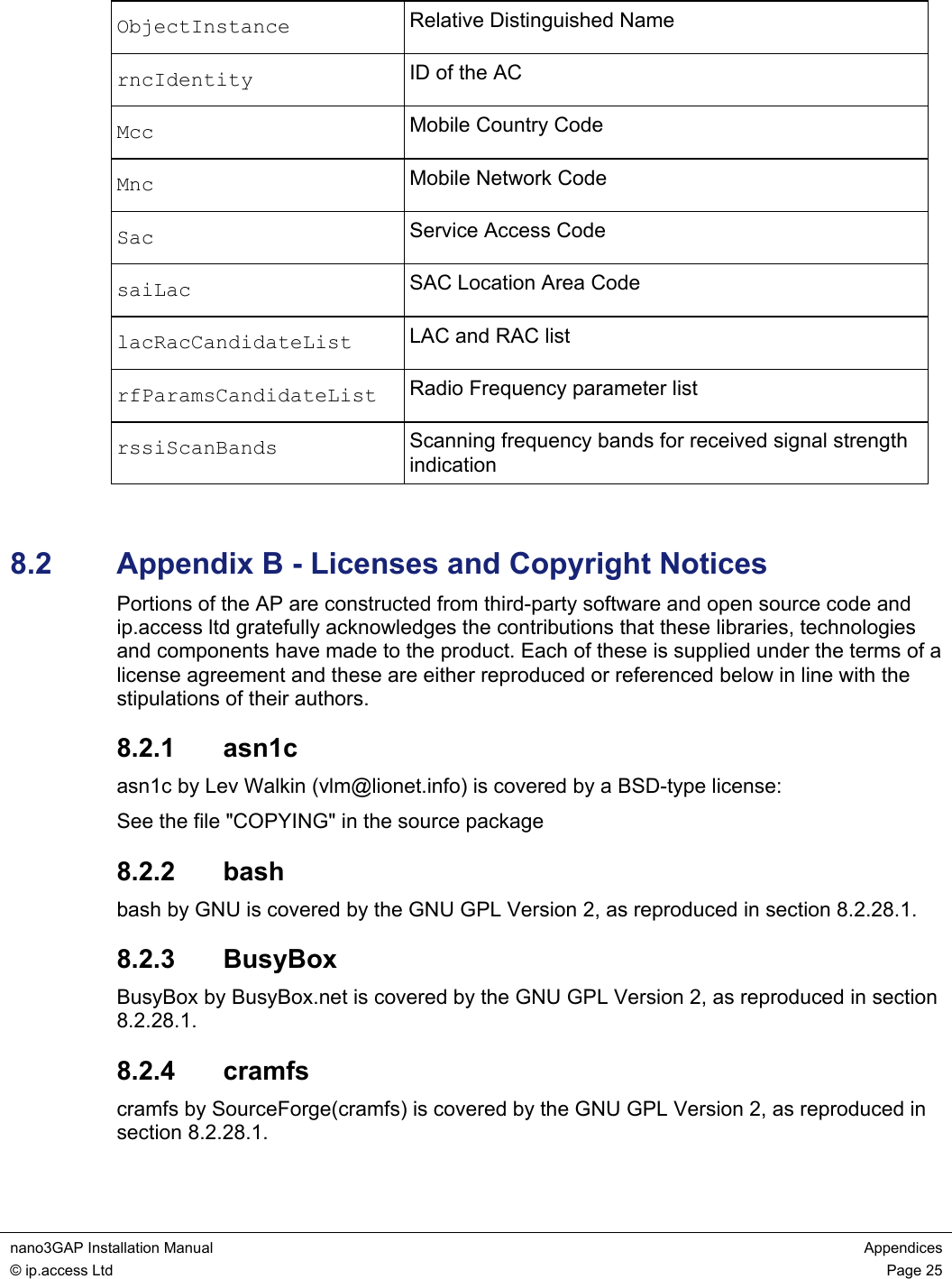
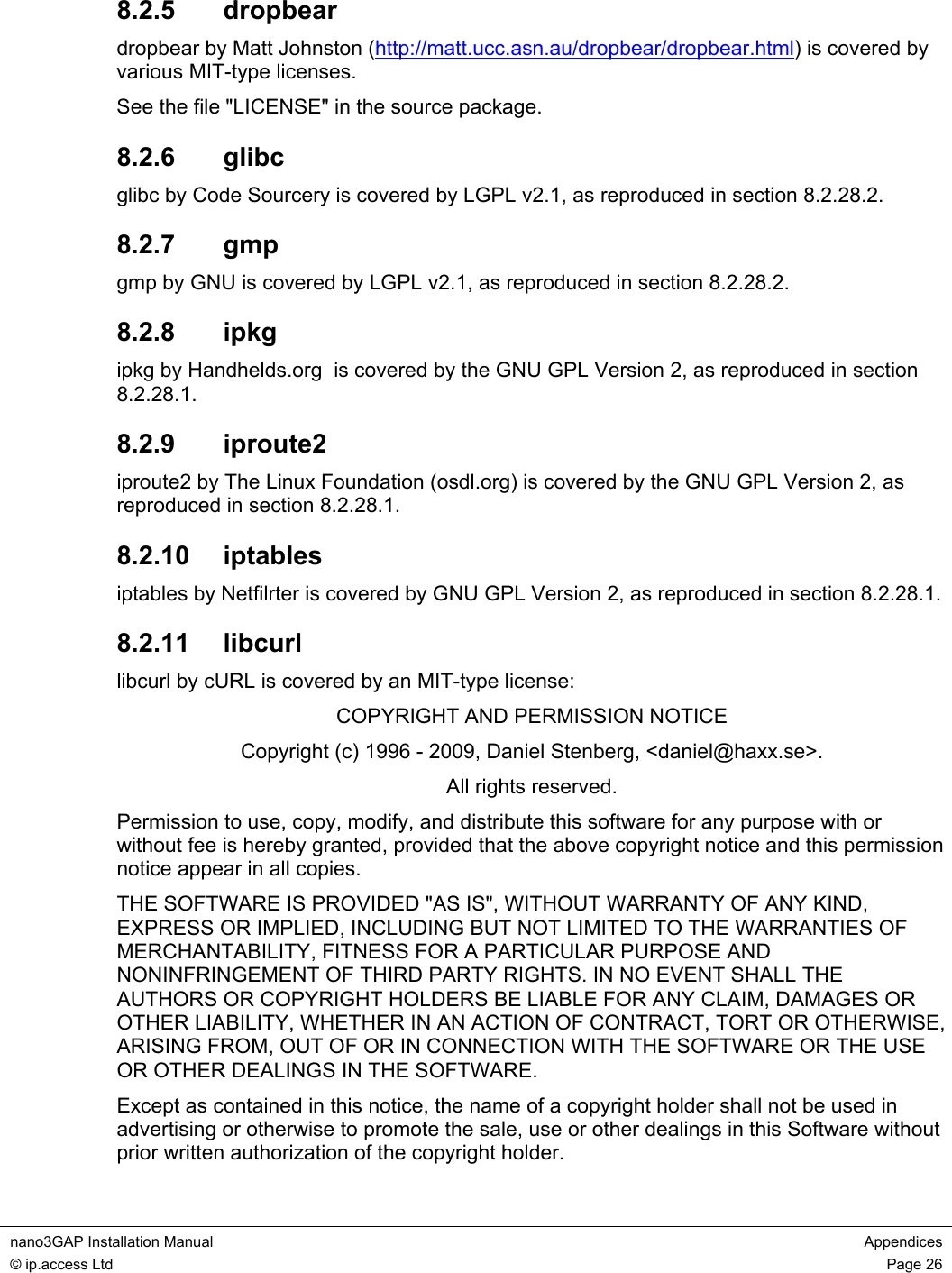
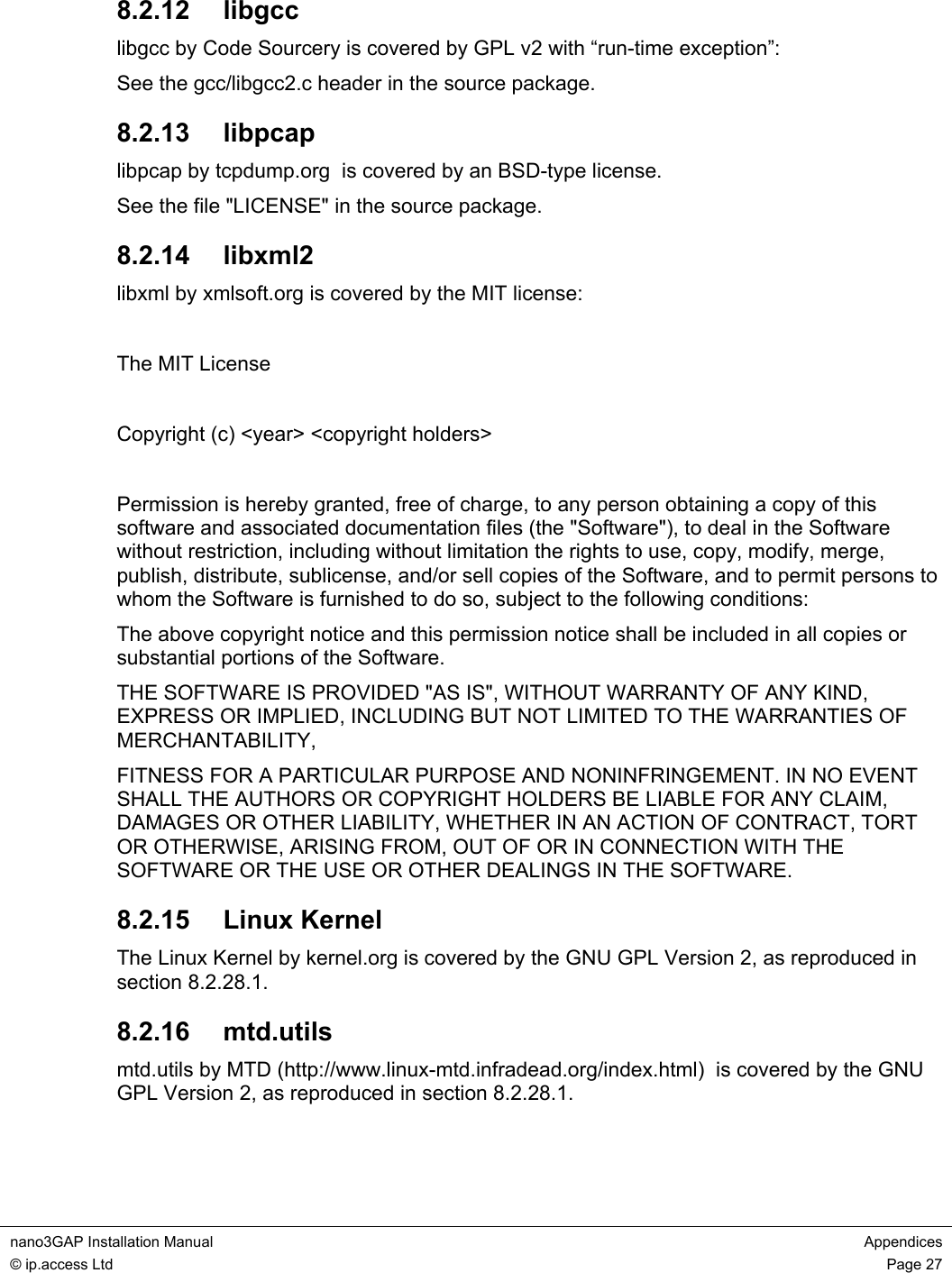
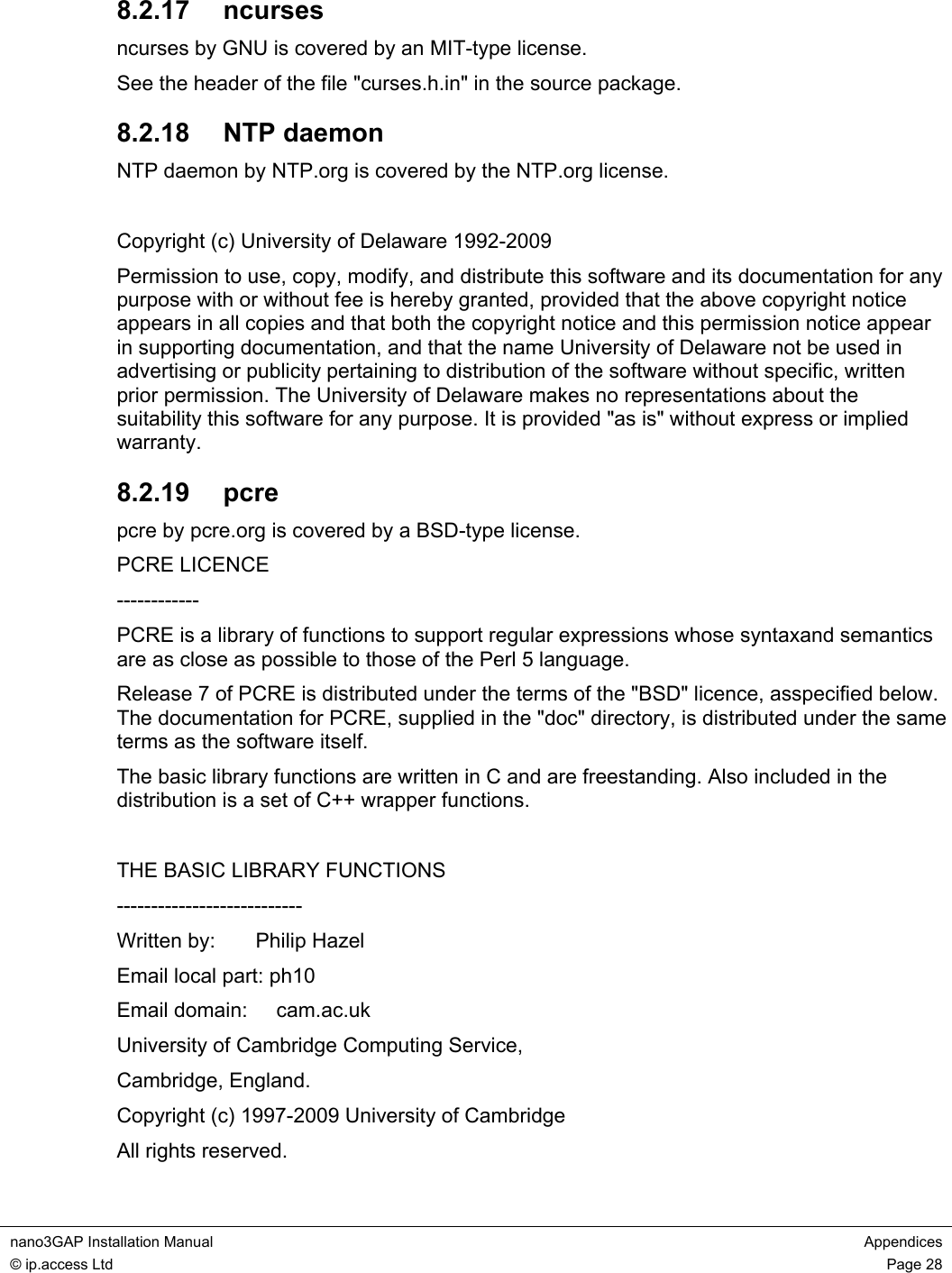
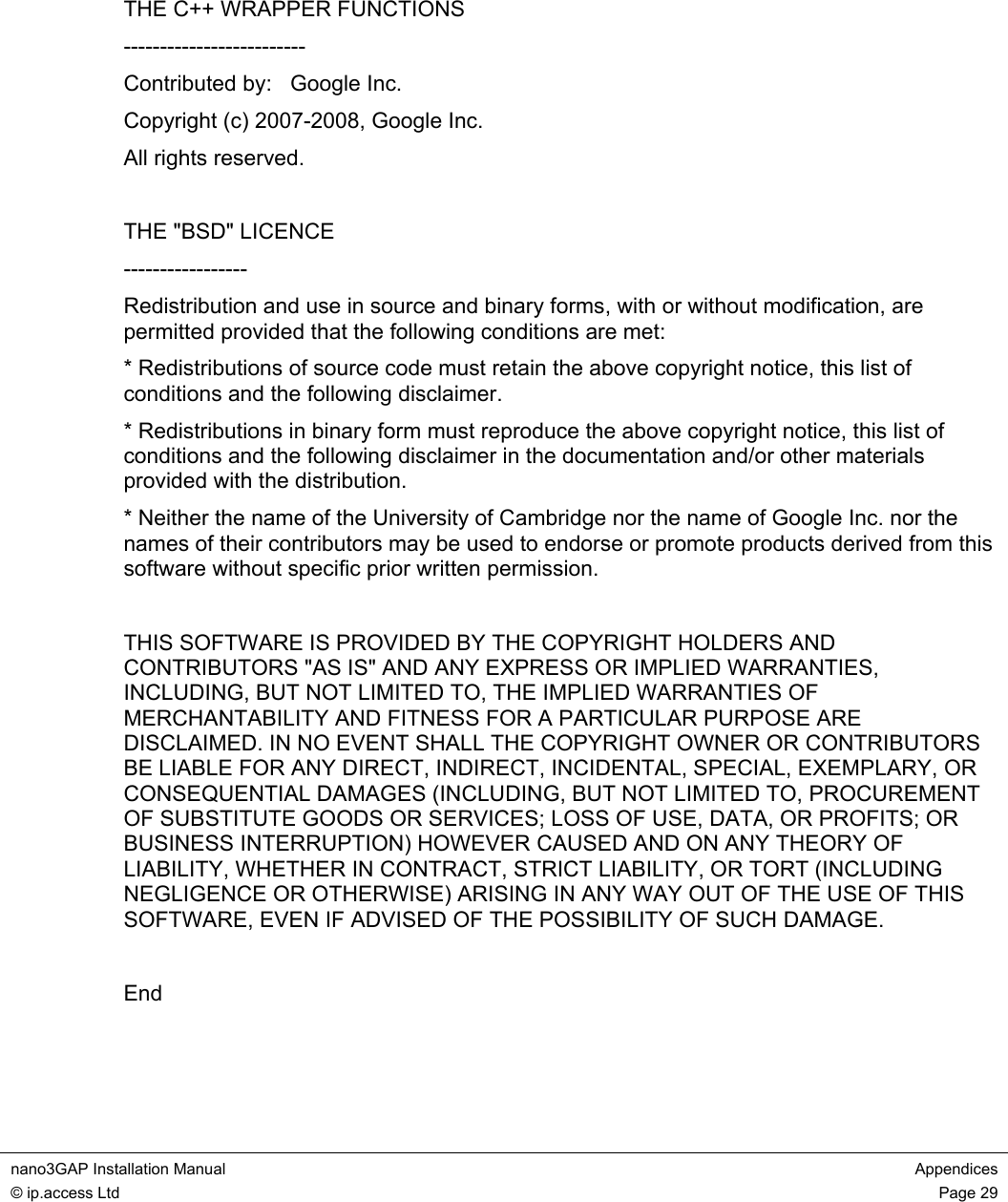
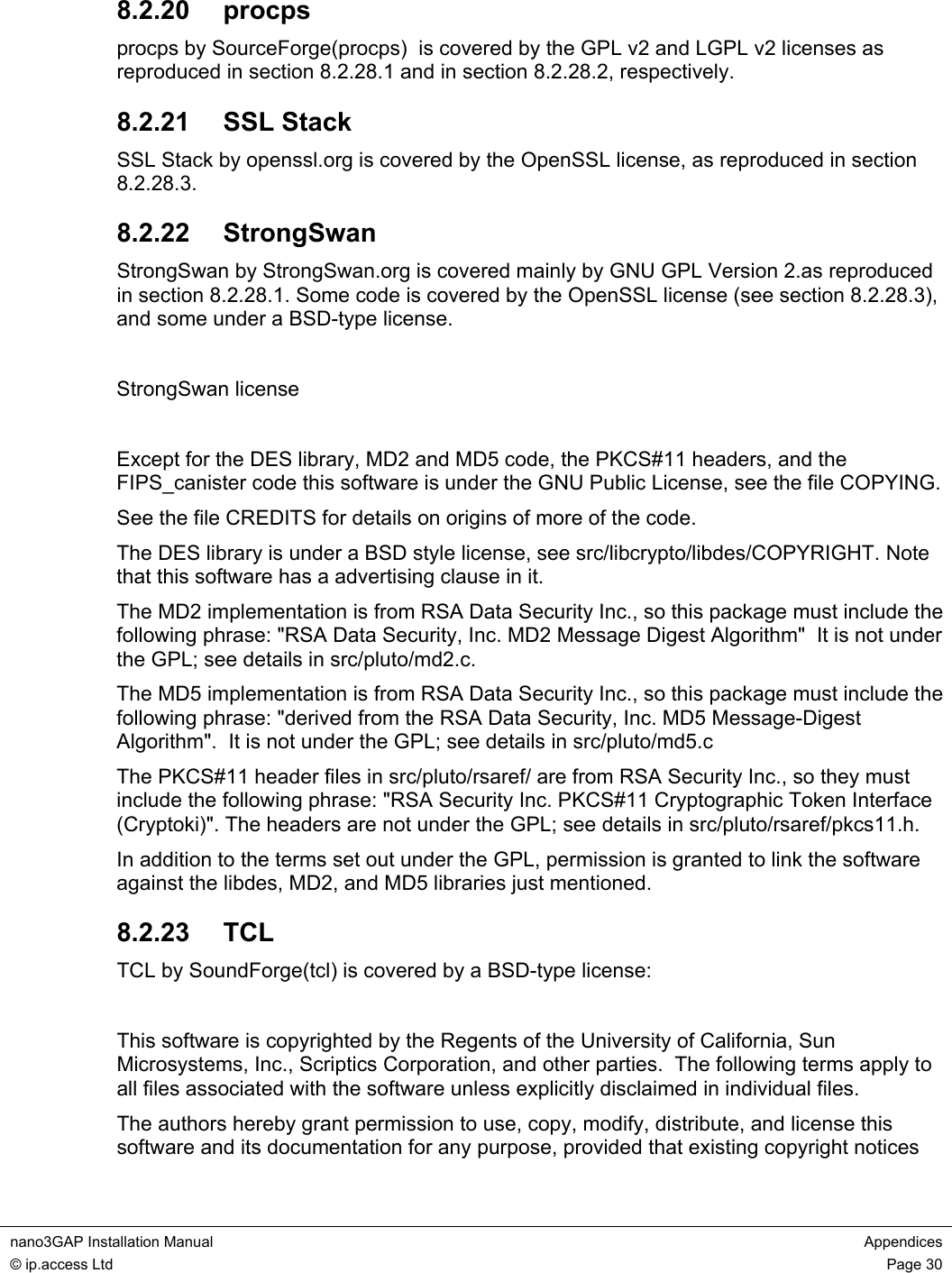
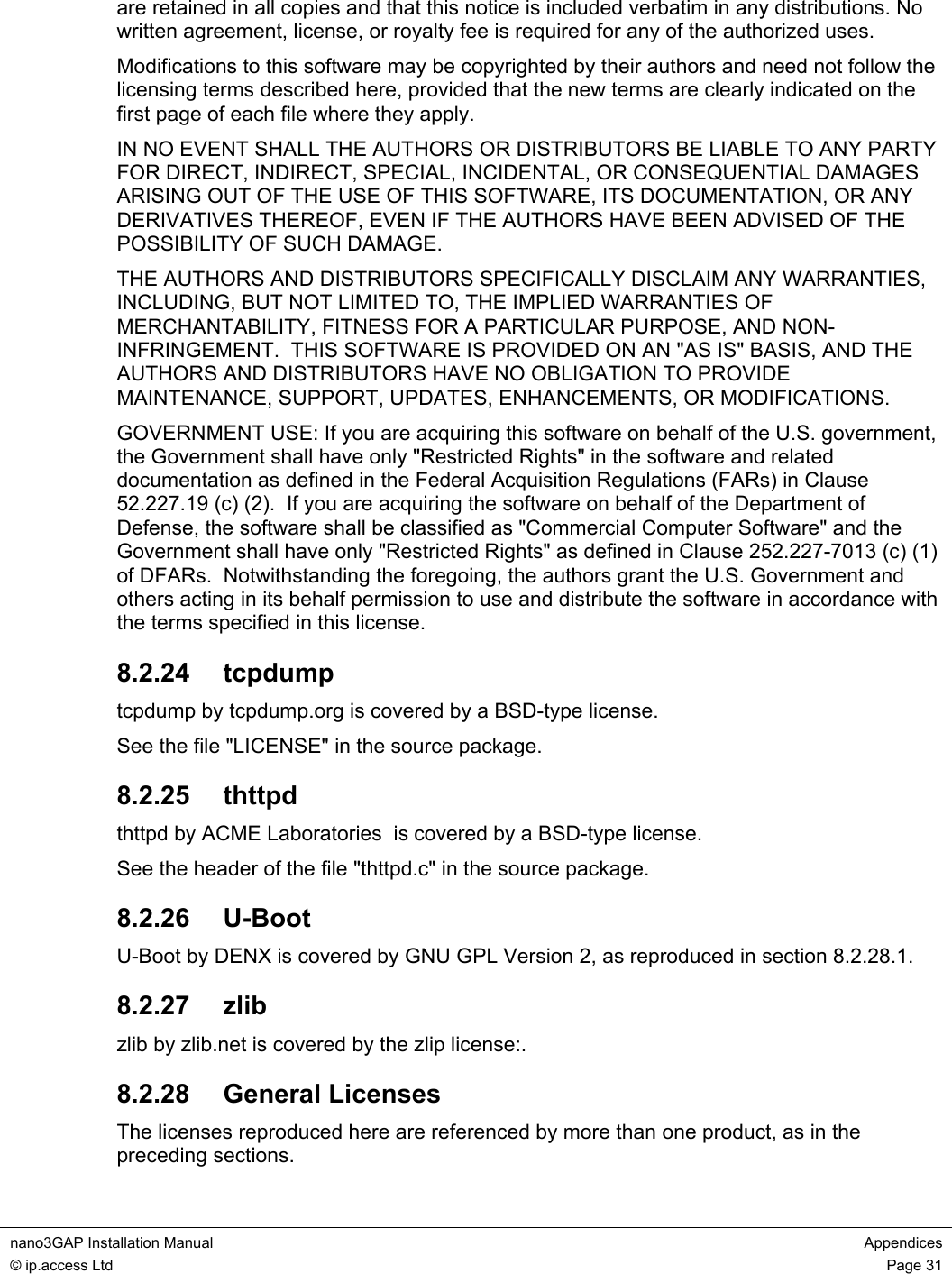
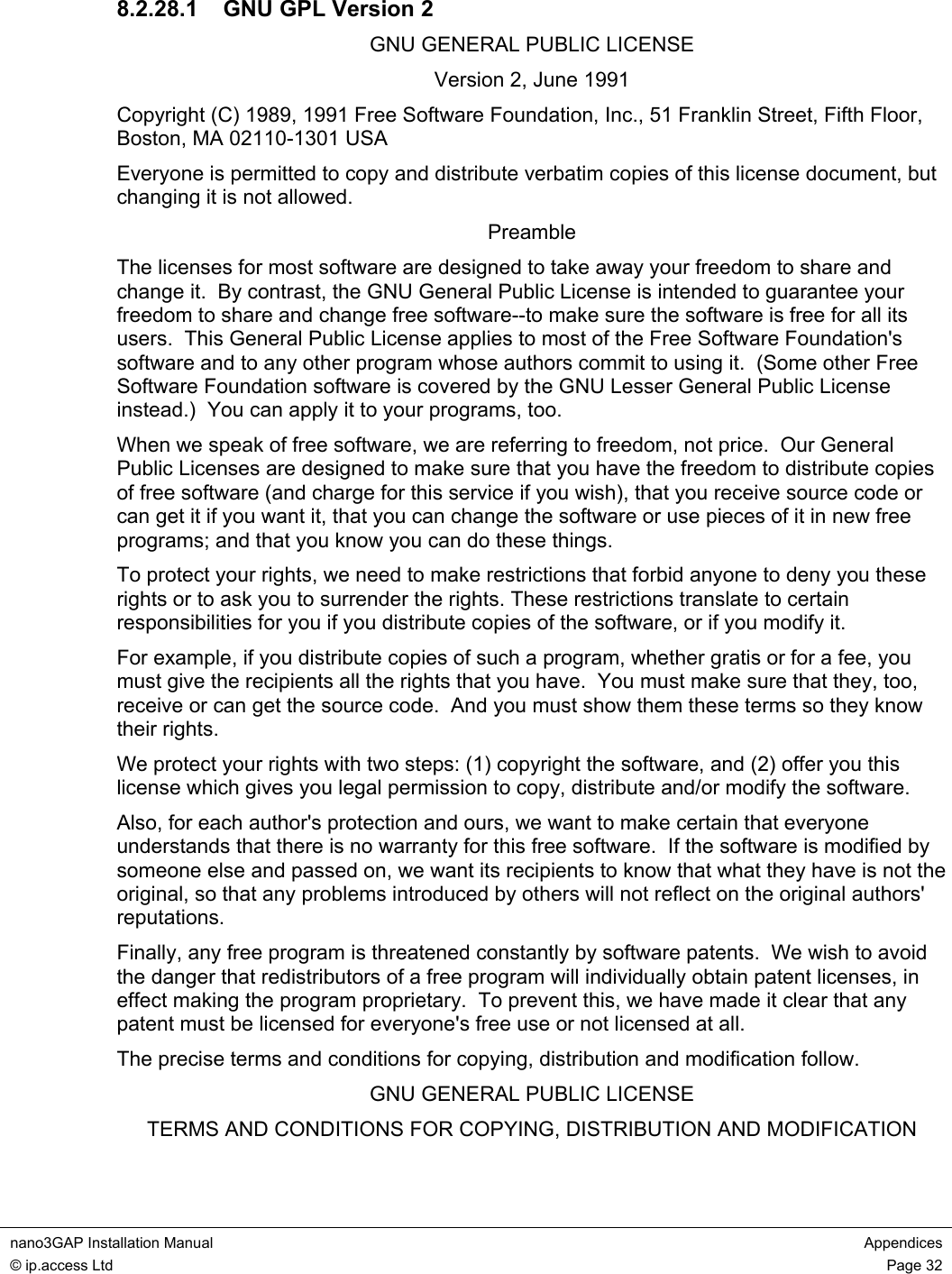
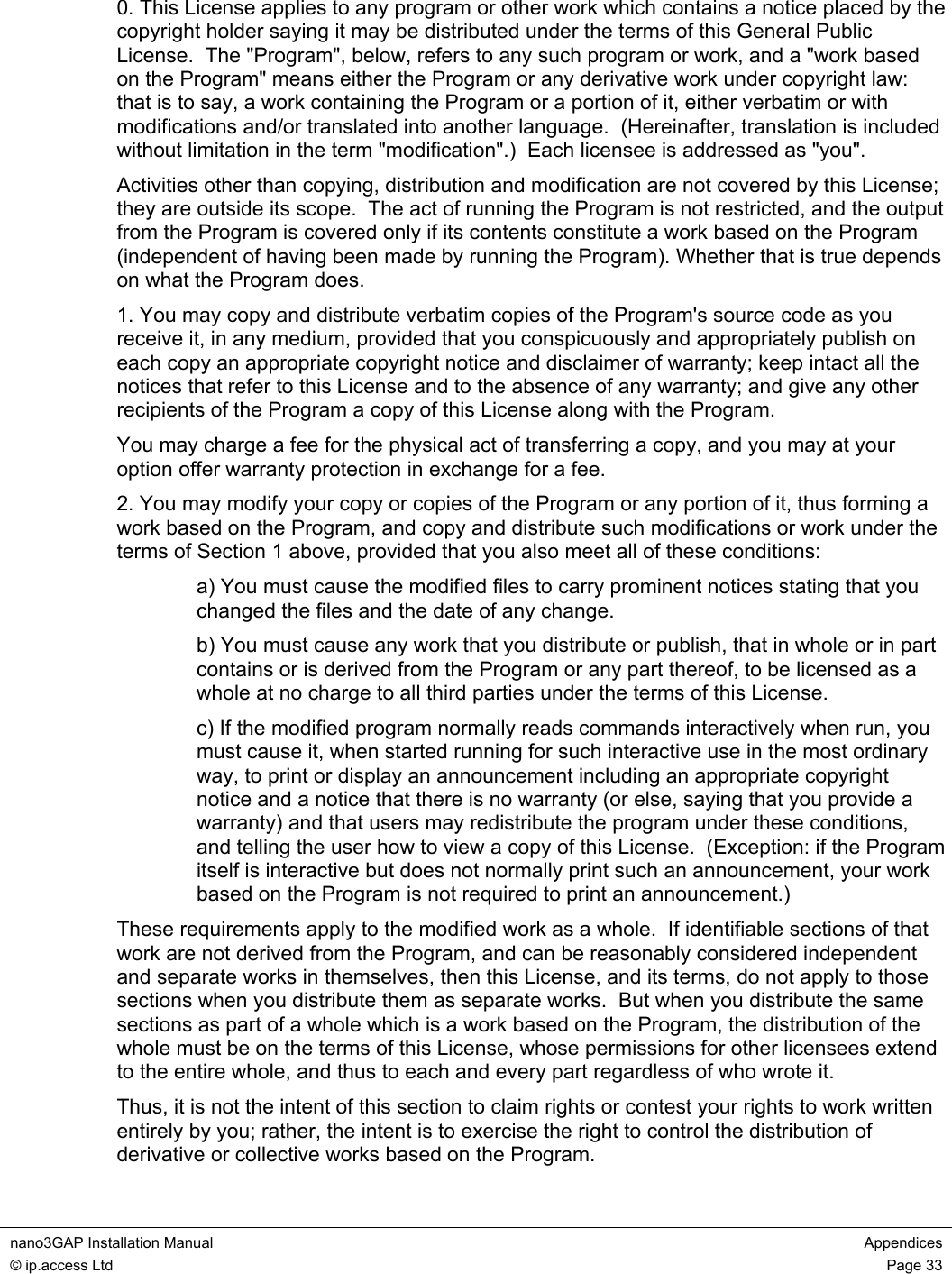
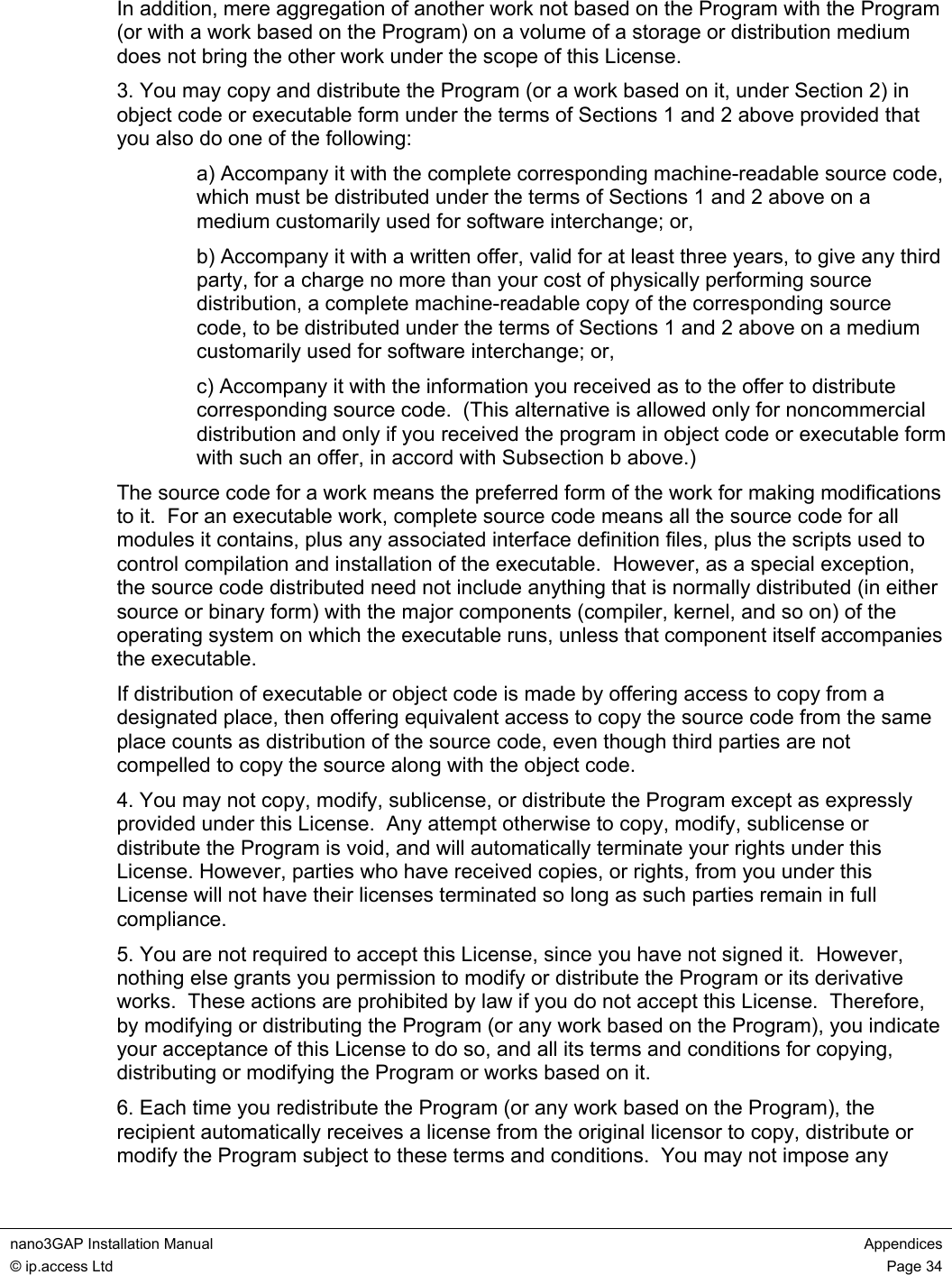
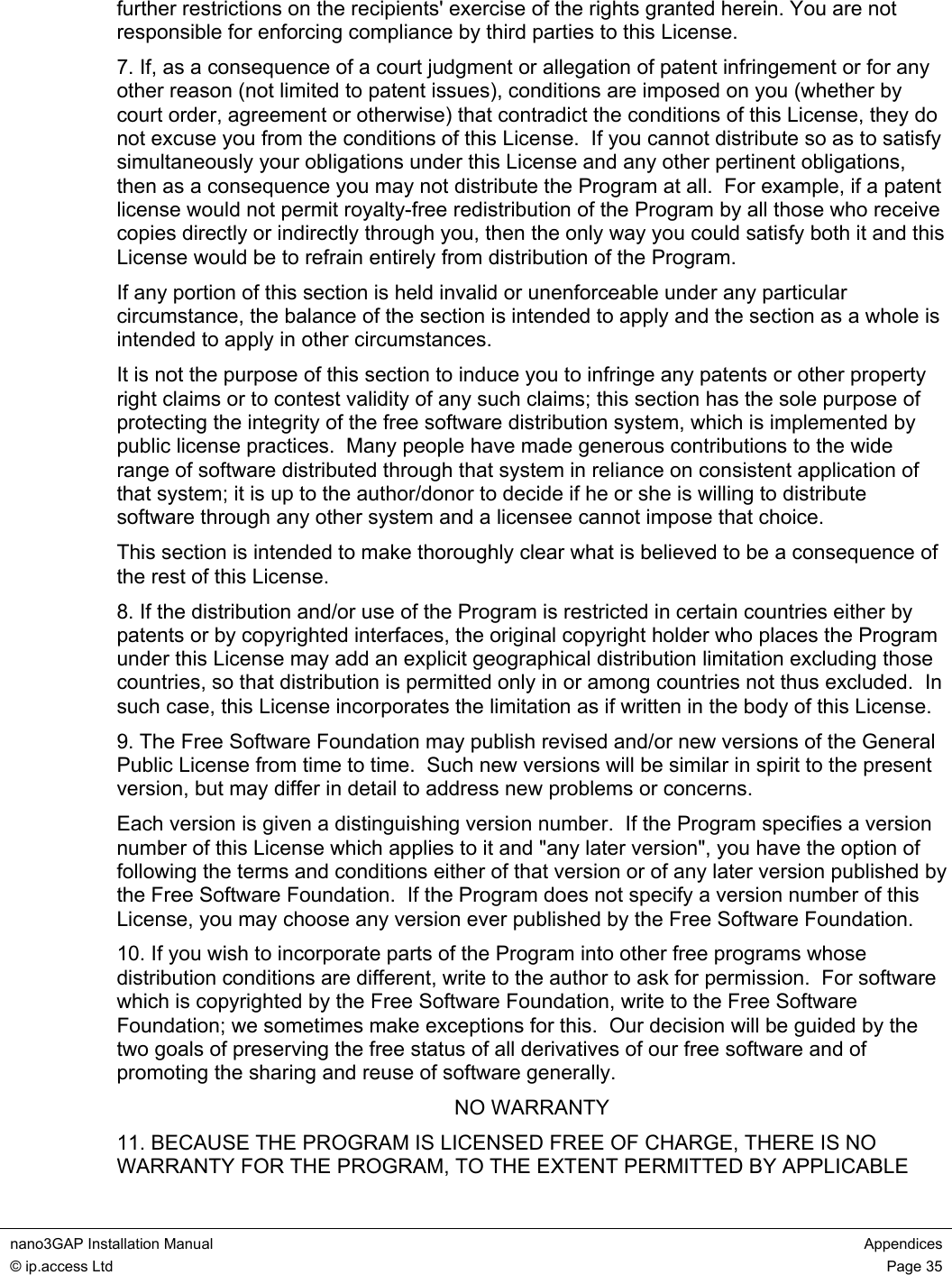
![nano3GAP Installation Manual Appendices © ip.access Ltd Page 36 LAW. EXCEPT WHEN OTHERWISE STATED IN WRITING THE COPYRIGHT HOLDERS AND/OR OTHER PARTIES PROVIDE THE PROGRAM "AS IS" WITHOUT WARRANTY OF ANY KIND, EITHER EXPRESSED OR IMPLIED, INCLUDING, BUT NOT LIMITED TO, THE IMPLIED WARRANTIES OF MERCHANTABILITY AND FITNESS FOR A PARTICULAR PURPOSE. THE ENTIRE RISK AS TO THE QUALITY AND PERFORMANCE OF THE PROGRAM IS WITH YOU. SHOULD THE PROGRAM PROVE DEFECTIVE, YOU ASSUME THE COST OF ALL NECESSARY SERVICING, REPAIR OR CORRECTION. 12. IN NO EVENT UNLESS REQUIRED BY APPLICABLE LAW OR AGREED TO IN WRITING WILL ANY COPYRIGHT HOLDER, OR ANY OTHER PARTY WHO MAY MODIFY AND/OR REDISTRIBUTE THE PROGRAM AS PERMITTED ABOVE, BE LIABLE TO YOU FOR DAMAGES, INCLUDING ANY GENERAL, SPECIAL, INCIDENTAL OR CONSEQUENTIAL DAMAGES ARISING OUT OF THE USE OR INABILITY TO USE THE PROGRAM (INCLUDING BUT NOT LIMITED TO LOSS OF DATA OR DATA BEING RENDERED INACCURATE OR LOSSES SUSTAINED BY YOU OR THIRD PARTIES OR A FAILURE OF THE PROGRAM TO OPERATE WITH ANY OTHER PROGRAMS), EVEN IF SUCH HOLDER OR OTHER PARTY HAS BEEN ADVISED OF THE POSSIBILITY OF SUCH DAMAGES. END OF TERMS AND CONDITIONS 8.2.28.2 GNU LGPL v2.1 GNU Lesser General Public License Version 2.1, February 1999 Copyright (C) 1991, 1999 Free Software Foundation, Inc. 59 Temple Place, Suite 330, Boston, MA 02111-1307 USA Everyone is permitted to copy and distribute verbatim copies of this license document, but changing it is not allowed. [This is the first released version of the Lesser GPL. It also counts as the successor of the GNU Library Public License, version 2, hence the version number 2.1.] Preamble The licenses for most software are designed to take away your freedom to share and change it. By contrast, the GNU General Public Licenses are intended to guarantee your freedom to share and change free software--to make sure the software is free for all its users. This license, the Lesser General Public License, applies to some specially designated software packages--typically libraries--of the Free Software Foundation and other authors who decide to use it. You can use it too, but we suggest you first think carefully about whether this license or the ordinary General Public License is the better strategy to use in any particular case, based on the explanations below. When we speak of free software, we are referring to freedom of use, not price. Our General Public Licenses are designed to make sure that you have the freedom to distribute copies of free software (and charge for this service if you wish); that you receive](https://usermanual.wiki/ip-access/IPA219C.Installation-manual/User-Guide-1170058-Page-40.png)
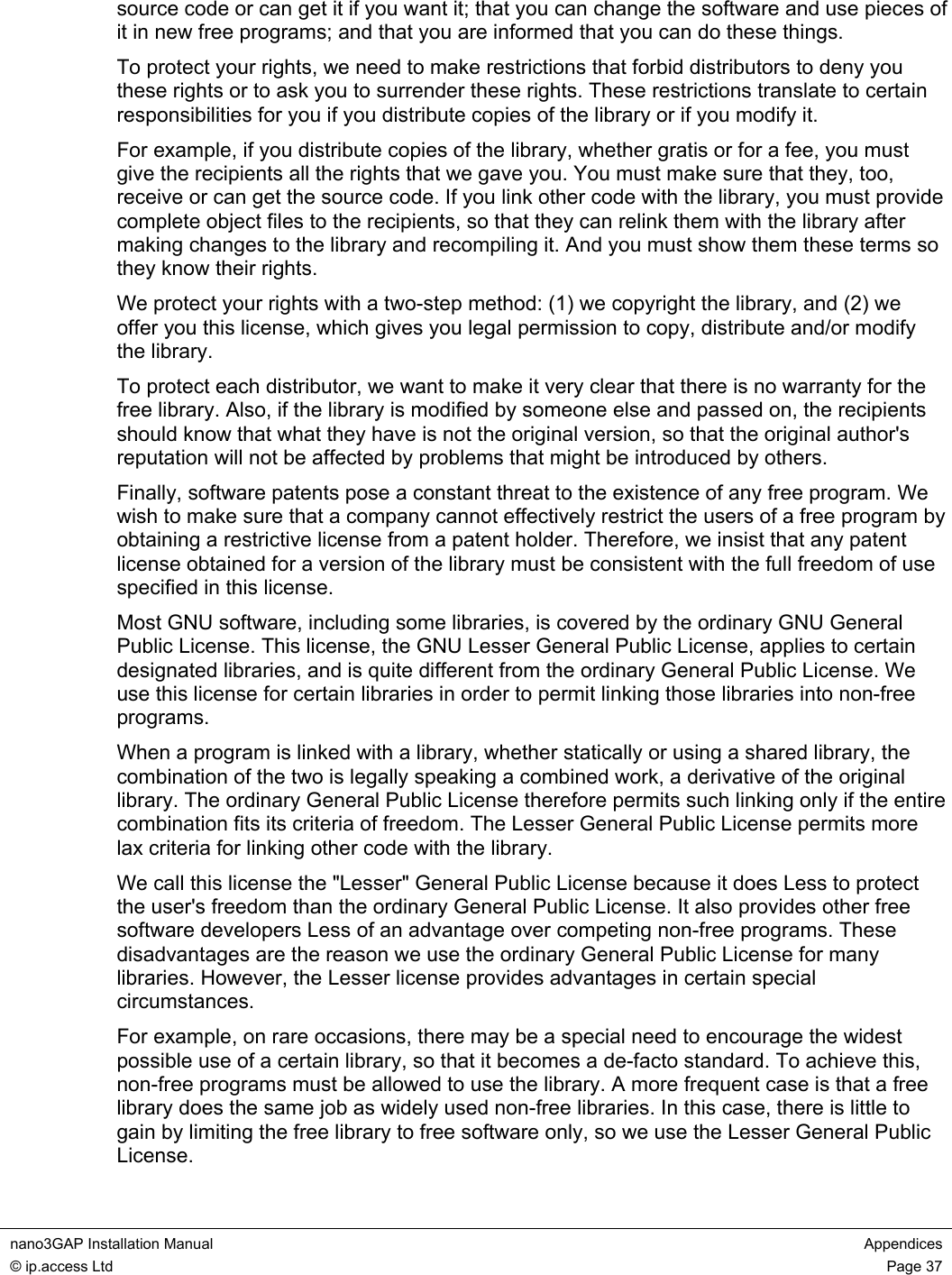
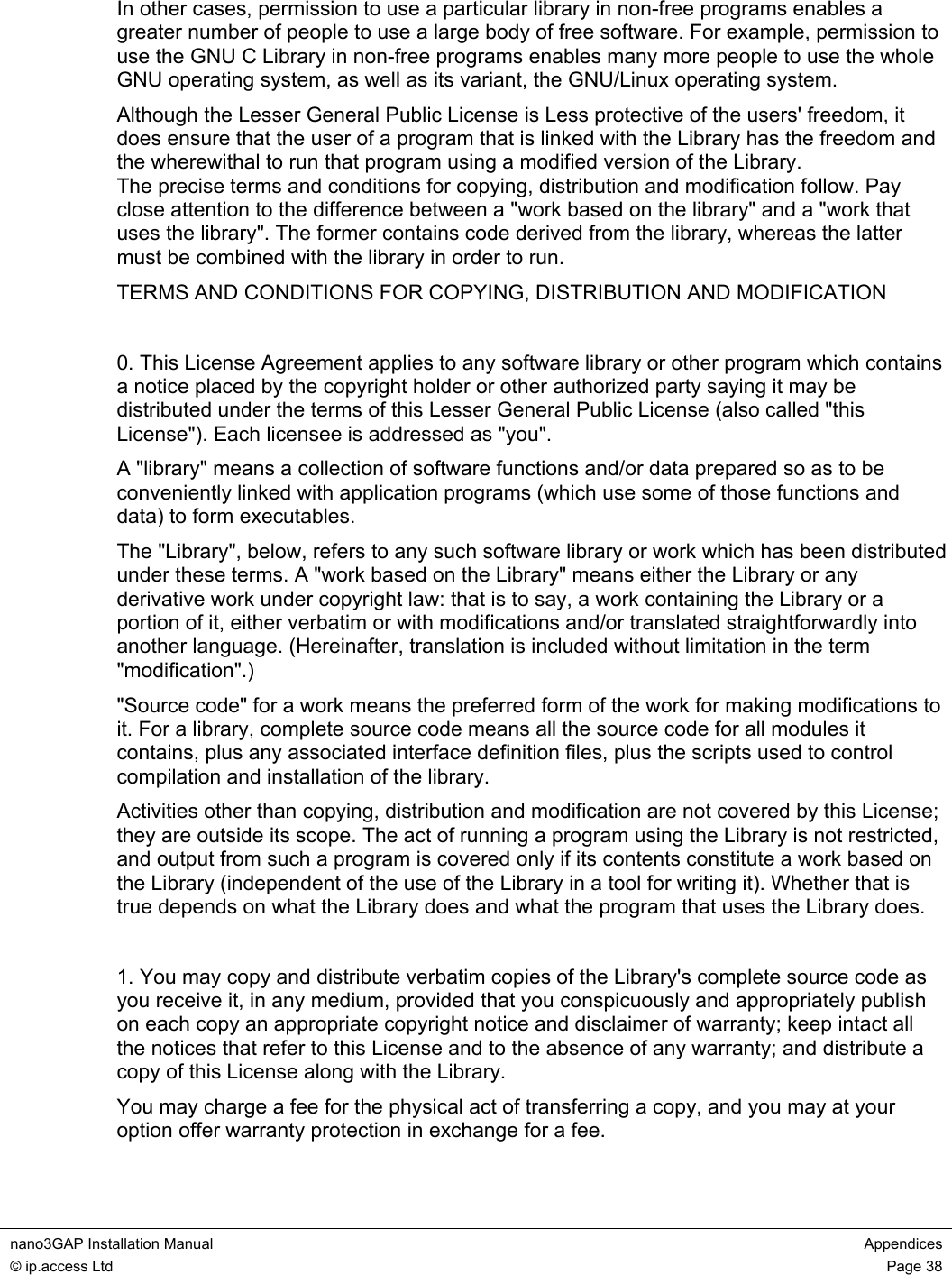
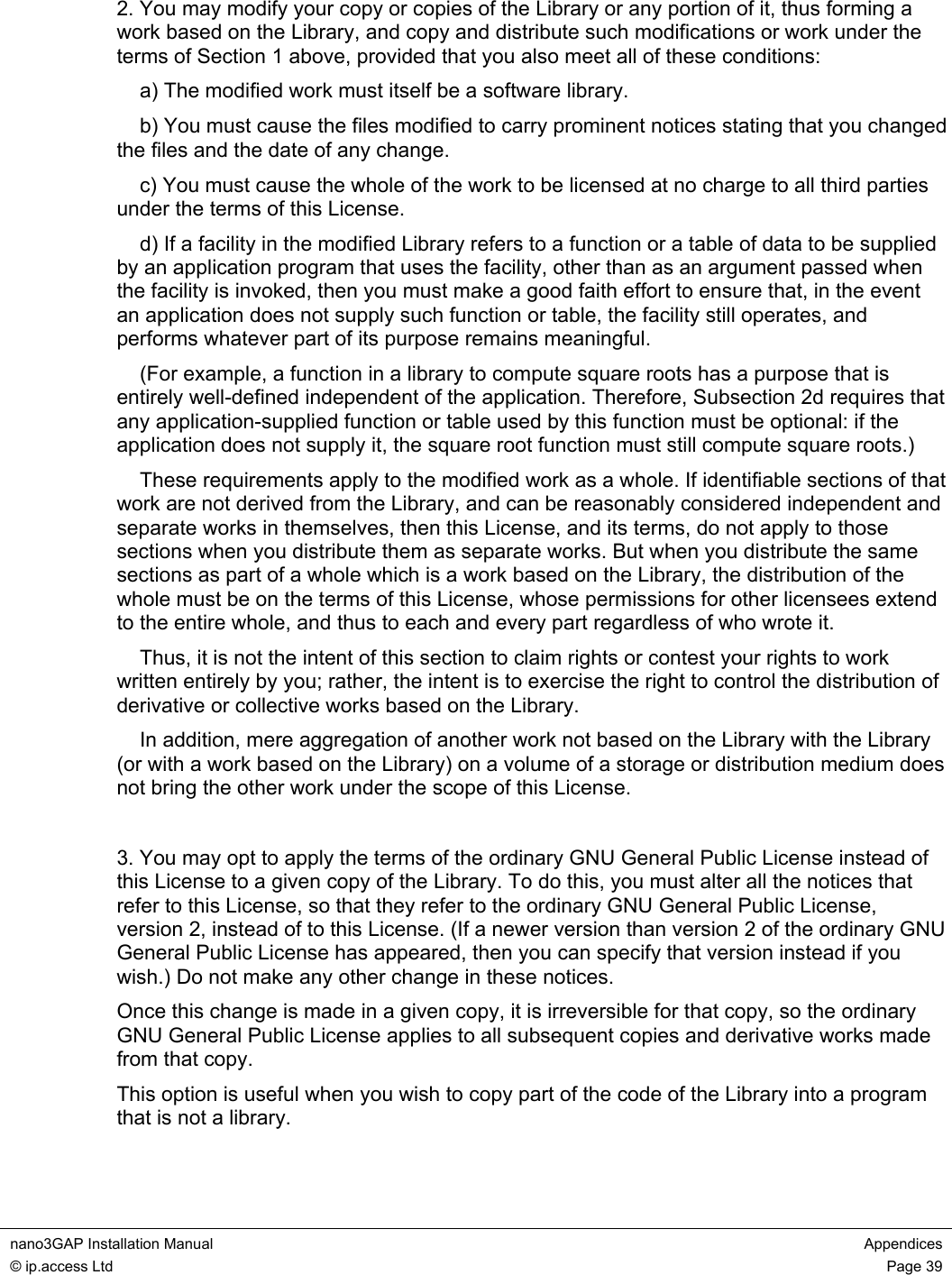
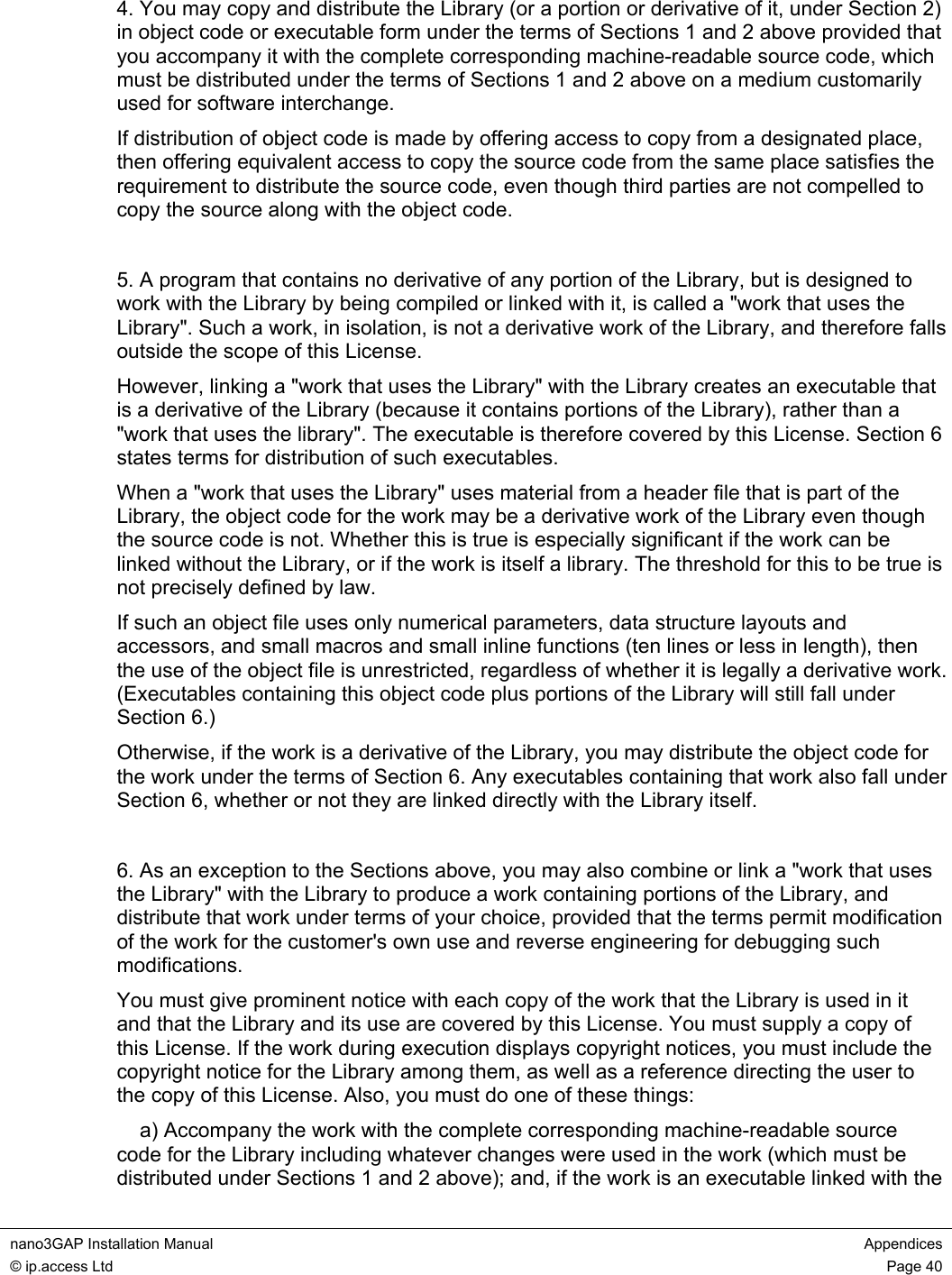
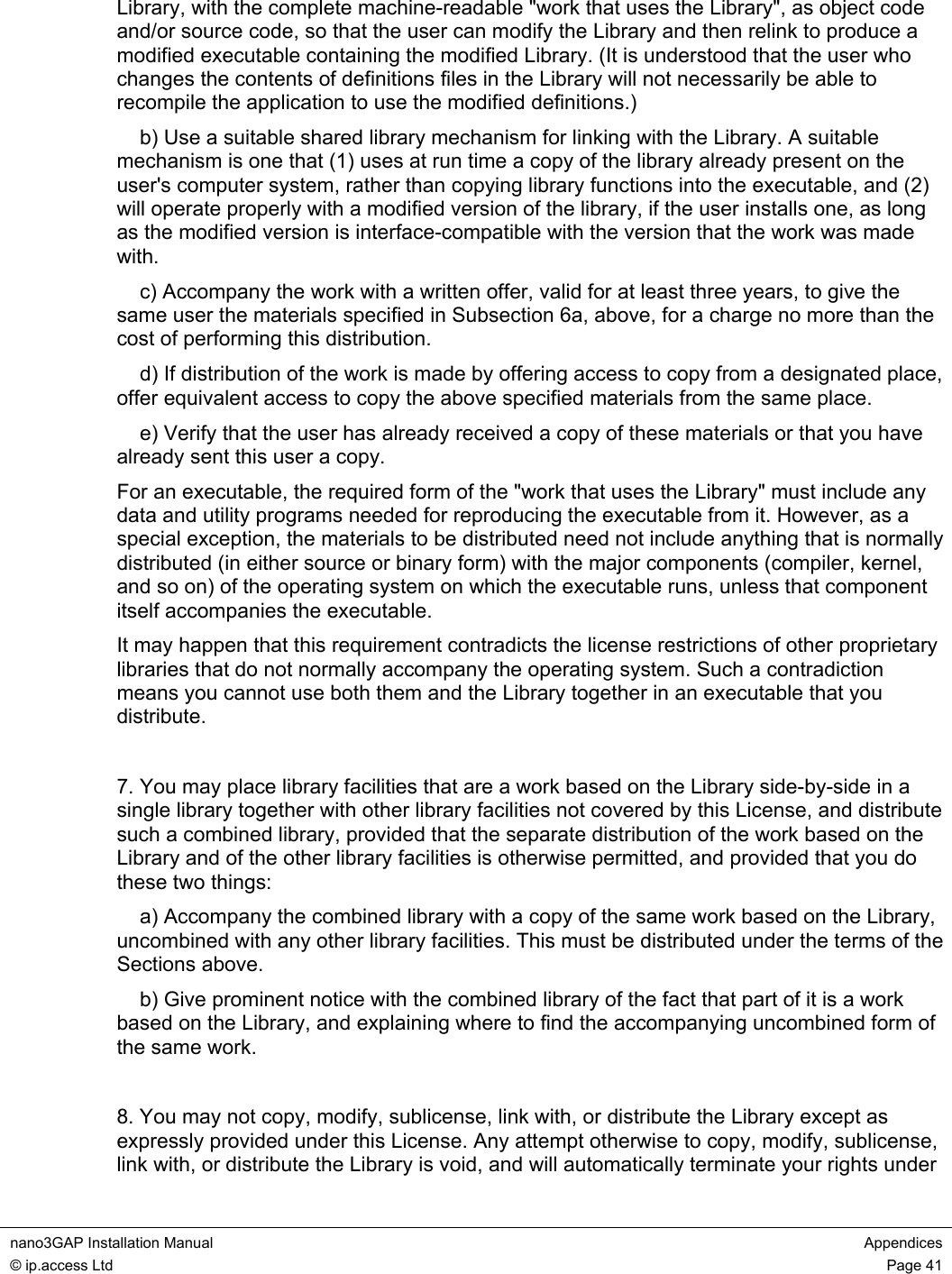
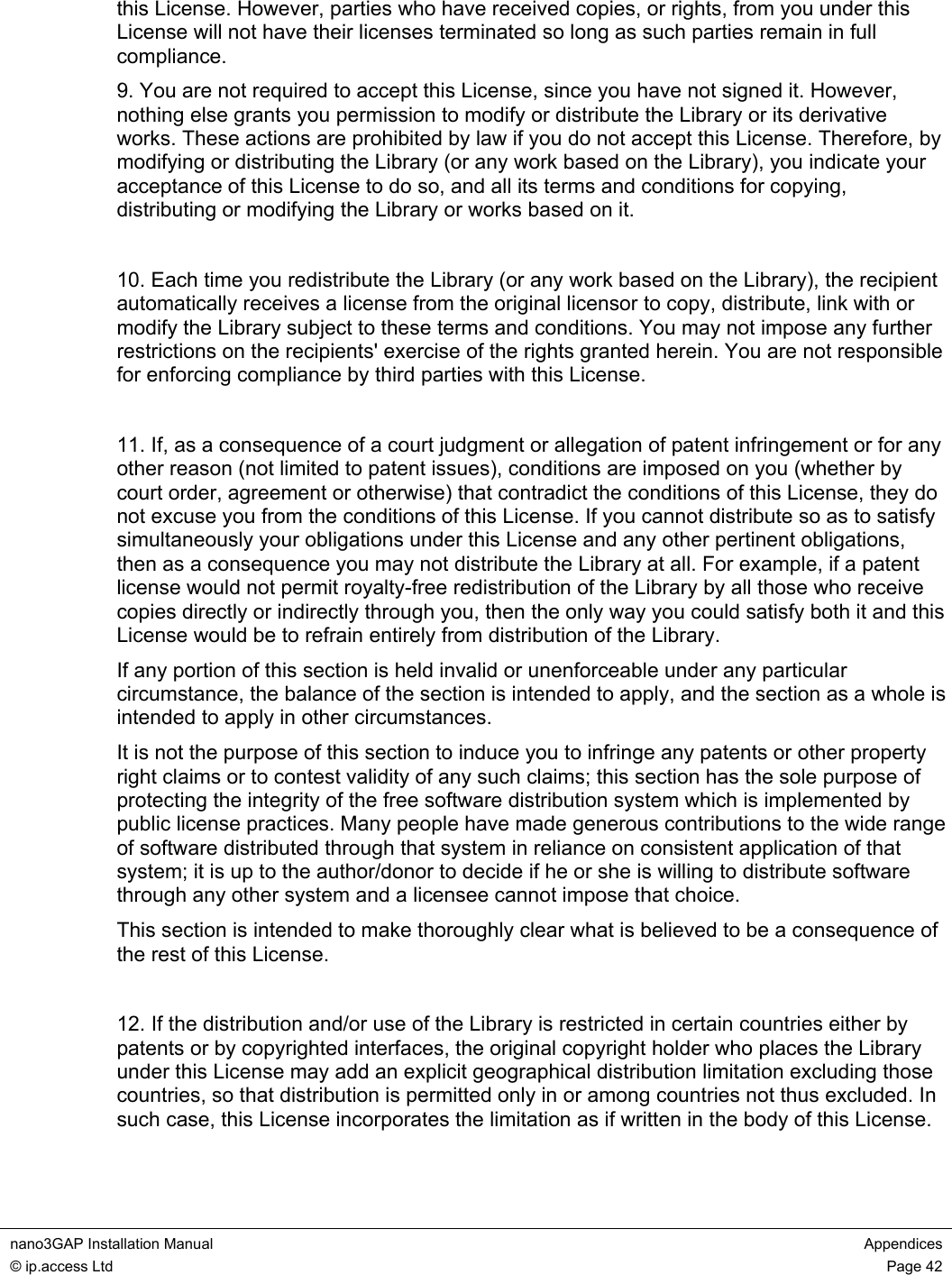
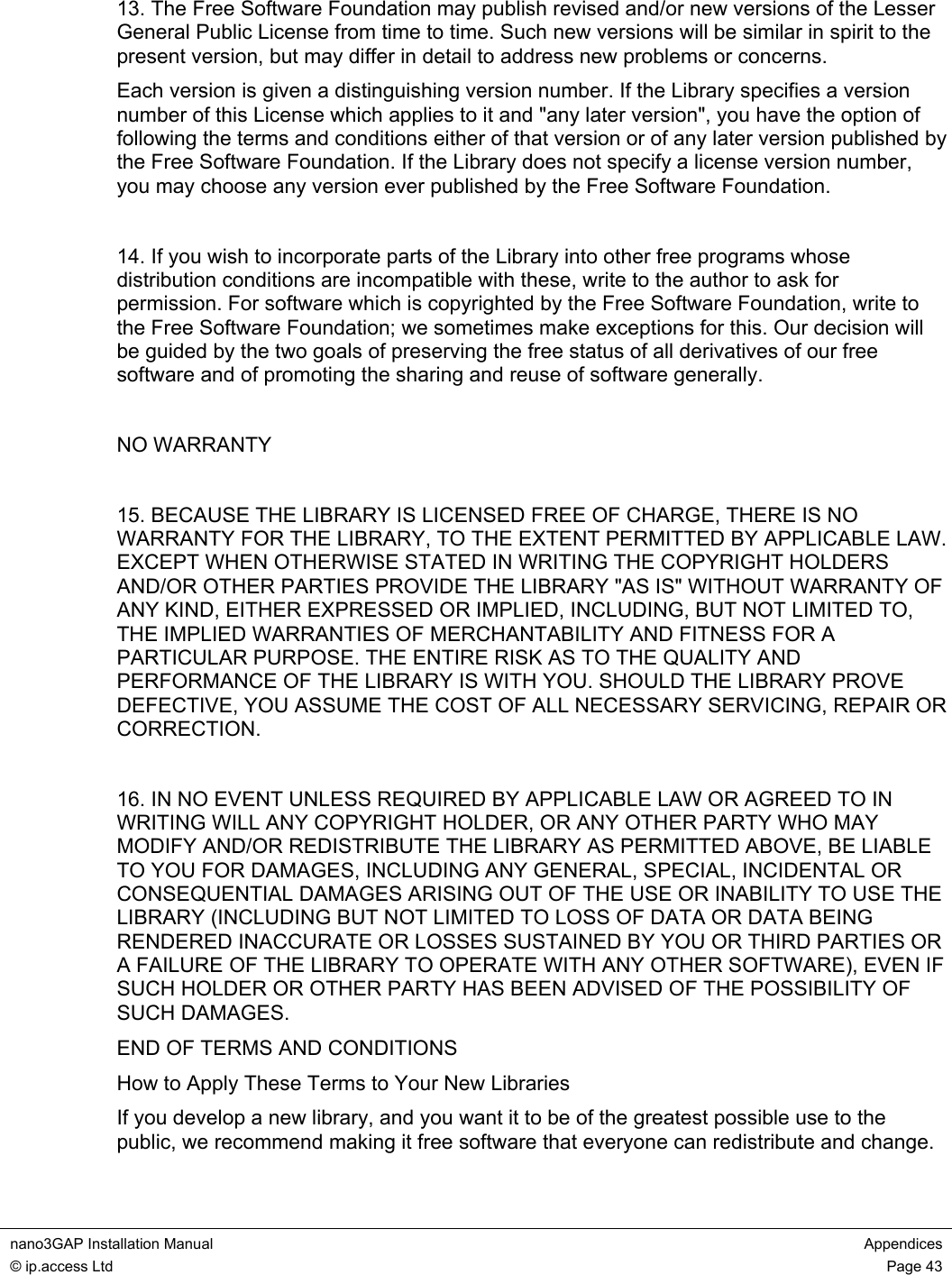
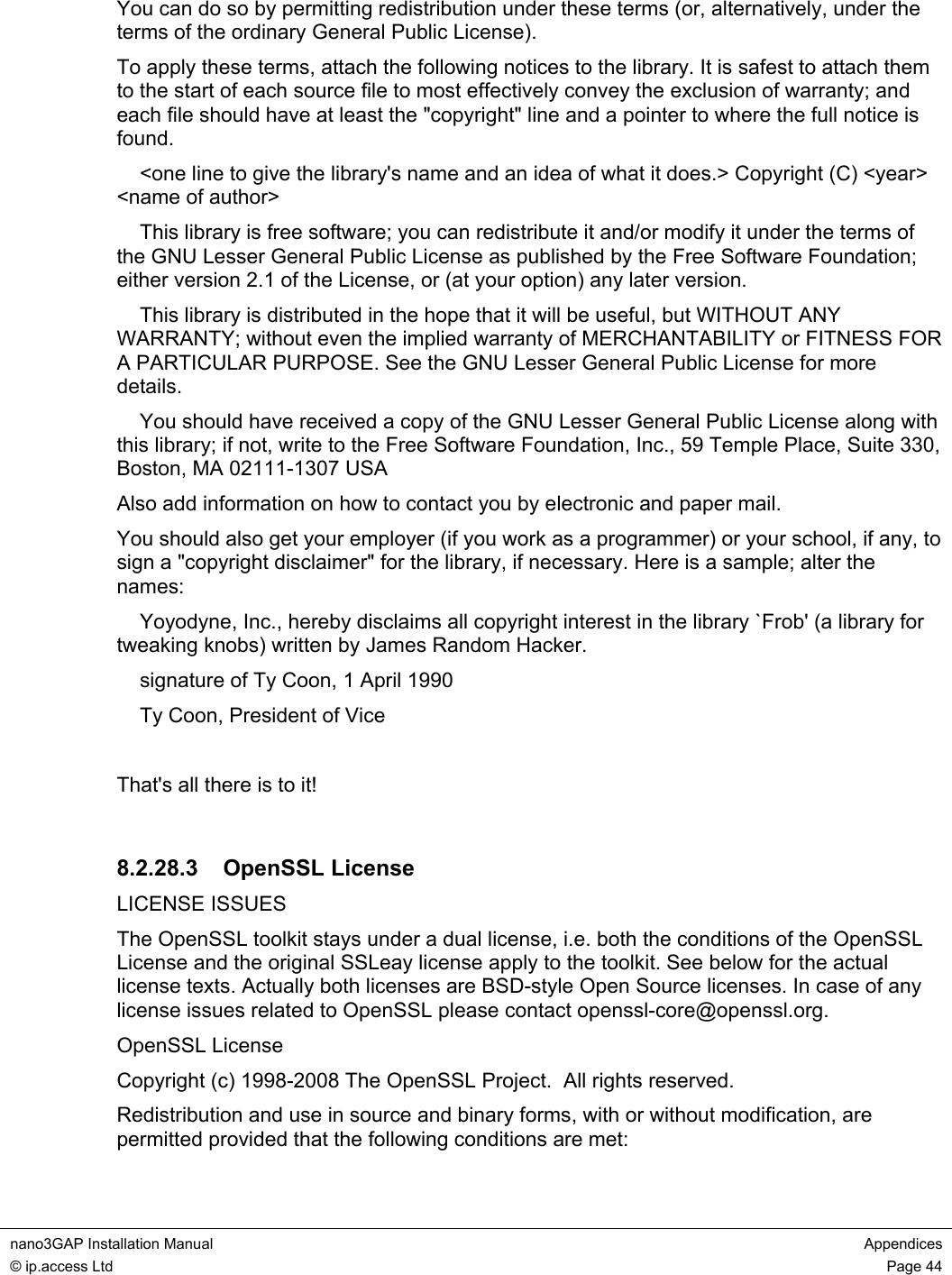
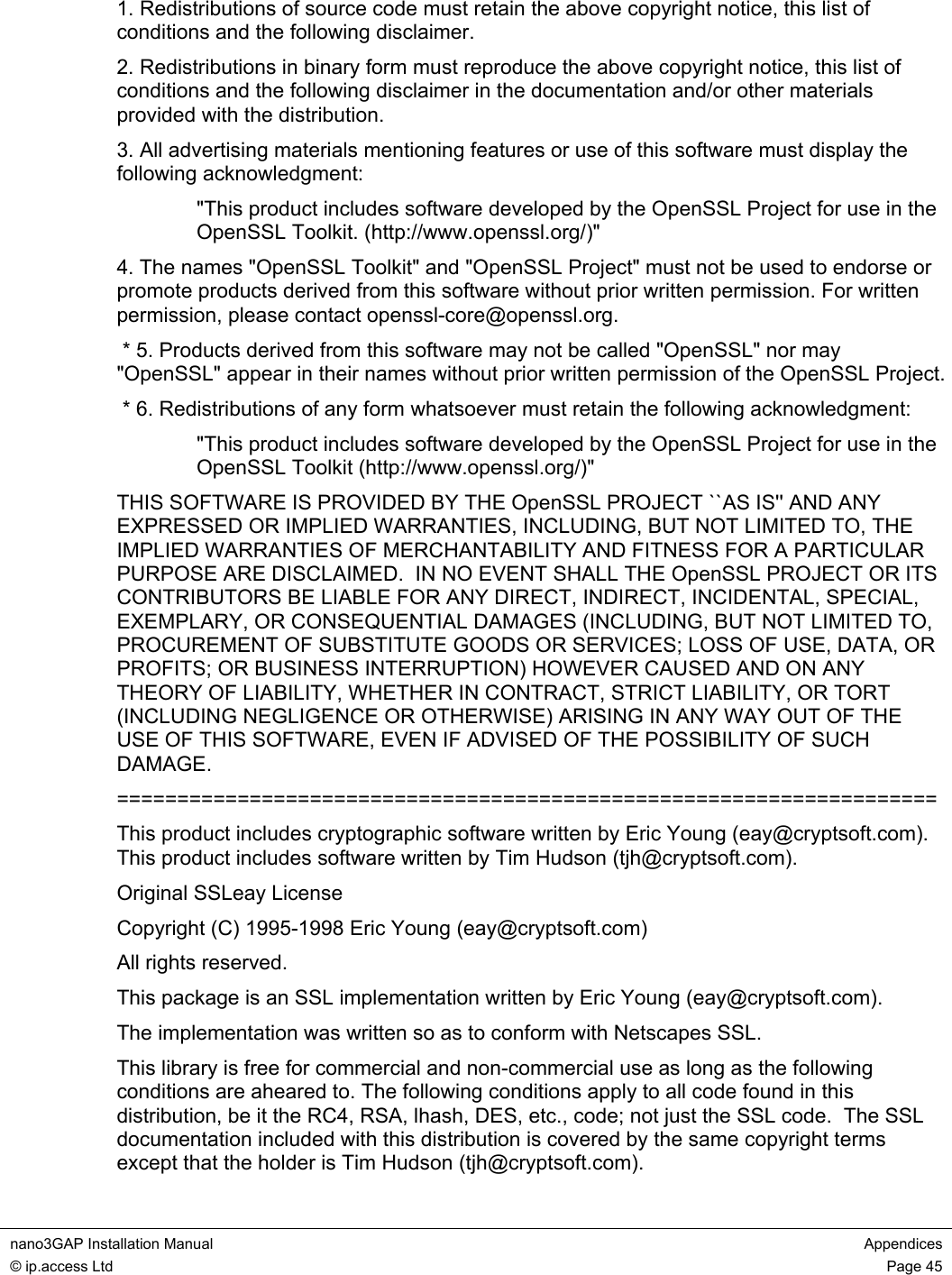
![nano3GAP Installation Manual Appendices © ip.access Ltd Page 46 Copyright remains Eric Young's, and as such any Copyright notices in the code are not to be removed. If this package is used in a product, Eric Young should be given attribution as the author of the parts of the library used. This can be in the form of a textual message at program startup or in documentation (online or textual) provided with the package. Redistribution and use in source and binary forms, with or without modification, are permitted provided that the following conditions are met: 1. Redistributions of source code must retain the copyright notice, this list of conditions and the following disclaimer. 2. Redistributions in binary form must reproduce the above copyright notice, this list of conditions and the following disclaimer in the documentation and/or other materials provided with the distribution. 3. All advertising materials mentioning features or use of this software must display the following acknowledgement: "This product includes cryptographic software written by Eric Young (eay@cryptsoft.com)" The word 'cryptographic' can be left out if the rouines from the library being used are not cryptographic related :-). 4. If you include any Windows specific code (or a derivative thereof) from the apps directory (application code) you must include an acknowledgement: "This product includes software written by Tim Hudson (tjh@cryptsoft.com)" THIS SOFTWARE IS PROVIDED BY ERIC YOUNG ``AS IS'' AND ANY EXPRESS OR IMPLIED WARRANTIES, INCLUDING, BUT NOT LIMITED TO, THE IMPLIED WARRANTIES OF MERCHANTABILITY AND FITNESS FOR A PARTICULAR PURPOSE ARE DISCLAIMED. IN NO EVENT SHALL THE AUTHOR OR CONTRIBUTORS BE LIABLE FOR ANY DIRECT, INDIRECT, INCIDENTAL, SPECIAL, EXEMPLARY, OR CONSEQUENTIAL DAMAGES (INCLUDING, BUT NOT LIMITED TO, PROCUREMENT OF SUBSTITUTE GOODS OR SERVICES; LOSS OF USE, DATA, OR PROFITS; OR BUSINESS INTERRUPTION) HOWEVER CAUSED AND ON ANY THEORY OF LIABILITY, WHETHER IN CONTRACT, STRICT LIABILITY, OR TORT (INCLUDING NEGLIGENCE OR OTHERWISE) ARISING IN ANY WAY OUT OF THE USE OF THIS SOFTWARE, EVEN IF ADVISED OF THE POSSIBILITY OF SUCH DAMAGE. The licence and distribution terms for any publically available version or derivative of this code cannot be changed. i.e. this code cannot simply be copied and put under another distribution licence [including the GNU Public Licence.]](https://usermanual.wiki/ip-access/IPA219C.Installation-manual/User-Guide-1170058-Page-50.png)